Posts Tagged ‘Koala’
Tuesday, November 27th, 2012
 Shrinking Koala Habitat – completely dependent upon the whims of Australians, if we give a toss. Shrinking Koala Habitat – completely dependent upon the whims of Australians, if we give a toss.
Being systematically destroyed by O’Farrell Government Loggers across coastal New South Wales, Australia
.
Koala Habitat is being trashed across New South Wales
[Source: The following article was published as ‘When trees fall in the forests’, by Ben Cubby, Sydney Morning Herald, 20101112, ^http://www.smh.com.au/environment/conservation/when-trees-fall-in-the-forests-20101111-17pgt.html]
.
<<The dull, grinding roar of logging trucks has become background noise in the hills around Eden, on the New South Wales south coast. Equally familiar is the sight of people photographing the loggers’ loads as they are hauled down to the local woodchip mill and on to ships bound for Japan. The campaigners are looking for signs of tree trunks that have hollows and may have supported native sugar gliders or owls.
About 1,200 kilometres north, in the subtropical rainforest near Casino, botanists and zoologists are poring over maps and Google Earth, tracking breaches of logging conditions – trees cut down inside protection zones, trees felled that supported endangered wildlife or nourished other flora.
The tit-for-tat battle in the forests has led to frustration on all sides, with forestry workers complaining of ”manic hatred” directed at them. Anti-logging activists say the damage to state forests is systematic and routine, as established rules in the NSW Forest Agreements are disregarded.
”It’s not exactly a surprise to us that there are so many breaches because the fox is in charge of the hen house,” says Lisa Stone, a campaigner with South-East Forest Rescue. ”It keeps happening over and over again. You have got areas where they are supposed to be taking out single trees and then you go there and it’s practically clear-felled.”
For each state forest targeted for logging, a plan must be drawn up that leaves some trees untouched, in accordance with the ”environmental protection licences” issued to logging contractors working for the state government agency, Forests NSW.
.
What the hell is Government’s Forests NSW doing to Wildlife Habitat?
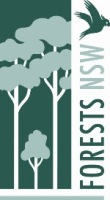
Forests NSW Greenwash:
.
“Forests NSW is committed to ensuring a supply of timber from NSW State forests today and into the future while also protecting other forest values such as biodiversity, clean air and water and public access for recreation. We are committed to running a safe and profitable business for the people of NSW.”
“The NSW (O’Farrell) Government has announced it will make Forests NSW a state owned corporation (SOC). Forests NSW will remain publicly owned and the nature of the business and business relationships will remain largely the same but the governance structures will change to improve the organisation’s commercial performance.
As a state owned corporation under the direction of a skilled commercial board, Forests NSW will be able to focus sharply on its core business of growing and harvesting timber to meet the community’s needs for hardwood and softwood products while still providing recreational opportunities for the people of New South Wales.”
[Source: ^http://www.forests.nsw.gov.au/]
.
Ed: So to the O’Farrell Government the forests are only about human needs – a babyboomer mindset, just like in the Old Testament. “..And God said unto them be fruitful, and multiply, and replenish the earth, and subdue it: and have dominion over the fish of the sea, and over the fowl of the air, and over every living thing that moveth upon the earth.” [Bible, Old Testament, Book of Genesis 1:28] ..and humans have been self-righteously buggering the planet ever since.
.
<<The many-layered oversight system produces a lot of work for the handful of NSW Department of Environment, Climate Change and Water staff, some of whom have found themselves visiting the same logging sites repeatedly.
Forests NSW stressed that a warning letter can refer to separate breaches, which partly explains why the number of warnings issued to Forests NSW is so much lower than the number of times rules get broken.
Nonetheless, department staff have told the Herald that guidelines are often applied indifferently by loggers and some contractors are serial offenders. Forests NSW has also lost staff through voluntary redundancy this year which, some workers argued, affects its ability to police logging contractors.
A spokeswoman for the Environment Department said logging licences contained ”strict provisions to protect the environment, threatened species and its habitat”. Audits of logging operations are carried out every month as part of its compliance program.
”[The department] is concerned about the number of recent alleged breaches being reported in the south-east of NSW and in response is conducting several comprehensive field audits of Forests NSW work in the region. If any of the alleged breaches are found to be substantiated then the [department] will take appropriate action.”
New spice has been added to the deluge of investigations by the recent so-called ”peace deal” in Tasmania, which saw major logging companies, including Gunns, agree to stop logging in old-growth native forests. The deal also included an effective end to large-scale burning of native timber as a source of renewable energy, a process that is now permitted in NSW. The National Association of Forest Industries said it would oppose any effort to transfer the Tasmanian deal to mainland Australia.
A woodchip company, South-East Fibre Exports, is planning to build the state’s first wood-fired electricity plant at Eden, burning ”offcuts”. The company says opposition to its power plant is driven by people with the broader agenda of ending logging in native forests altogether. This seems likely to be true. South-East Fibre Exports blames anti-logging campaigners for setting up a fake website that mocks the company’s proposal, and a campaigner against the power plant, the former fashion designer Prue Acton, found an electronic bugging device in her home earlier this year. No one knows who is responsible for planting the bug, and there is no suggestion it is linked to the logging dispute. Police are investigating.
The NSW Primary Industries Minister, Steve Whan, said he had faith in the forestry companies and Forests NSW. ”Allegations of ‘systematic damage’ are overstated,” says Whan. ”The majority of the alleged breaches in question are minor in nature – with little to no impact on the environment.”
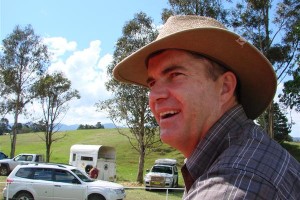 Former NSW Labor Minister for Minerals and Forest Resources, Steve Whan,
who also had Primary Industries, Emergency Services and Rural Affairs – i.e. politically imposed conflicts of interests. Former NSW Labor Minister for Minerals and Forest Resources, Steve Whan,
who also had Primary Industries, Emergency Services and Rural Affairs – i.e. politically imposed conflicts of interests.
.
In southern NSW, the forestry organisation is regularly scrutinised and was operating within the rules.
”Forests NSW southern region has received no penalty notices and not one case has been brought to prosecution for at least the past three years. ‘As a local member in the area as well as the Minister for Forest Resources, I personally welcome the intense environmental scrutiny that forestry operations in the area are subjected to. It is very important that any logging operations in the region comply with all the environmental conditions in place.”
Documents maintained by Forests NSW staff show there were 13 breaches recorded in south-eastern NSW last year.The breaches include cases of ”lack of care taken by operator”, ”operator did not see marking tape” and ”poor rigour in completing surveys”. Some could be explained by mishaps such as a vehicle slipping on a steep hillside into a protected area. In one case a logging contractor cut down trees in an area marked as ”old growth forest” because a global positioning system device had run out of batteries.
Of the 13 recorded incidents, eight resulted in verbal warnings to forestry contractors and one, in which the estimate of damage made by environment department staff differed from Forests NSW’s, resulted in a warning letter. Environmental damage was in every case assessed to be ”nil” and no remedial action was taken.
In part, the mistakes could be put down to forestry workers working to tight deadlines in rugged terrain.
But anti-logging activists are not prepared to be that charitable. The parallels with the situation in northern NSW are remarkable. In the state forests around Casino and Tenterfield, a group called North-East Forest Alliance has identified damage to stands of trees inhabited by koalas, stuttering frogs, sooty owls, powerful owls, golden-tipped bats and yellow-bellied gliders. The same types of breaches are evident, with contractors failing to follow guidelines about properly marking up vulnerable trees. Trees up to two metres wide at the base were cut down inside an area of rainforest described as a ”special protection zone”.
Five sets of allegations, covering dozens of alleged individual breaches in separate forests, were sent to the Environment Department early this year. Staff undertook a joint investigation with the forestry agency, and Forests NSW said a ”compliance response team” had been established.
South-East Forest Rescue recently surveyed state forests at Mogo, near Batemans Bay, and found recent logging in areas that were supposed to have been preserved, including an Aboriginal cultural site and conservation areas. In a report sent to the government, it alleges that many hectares of forest that should have been off-limits to loggers had been cleared.
The group has also walked through south coast state forests Tantawangalo, Yambulla, Glenbog and Dampier, collecting photographs of logging sites. Earlier surveys of the various regions by the Environment Department show habitat supporting sooty owls, yellow-bellied gliders, square-tailed kites, giant burrowing frogs, bent wing bats, tiger quolls, glossy black cockatoos and powerful owls may have been damaged.
The group’s surveys have been passed on to the Environment Department. The department said its own studies in the area are expected to run until mid-November. Stone says the group wanted Whan to visit the logging locations they had surveyed.>>
.
.
Koala habitat faces bulldozing in Victoria
[Source: ‘Super-koala’ habitat faces bulldozing, by Claire Miller, 20051002, ^ http://www.theage.com.au/news/national/superkoala-habitat-faces-bulldozing/2005/10/01/1127804696947.html]
 Susie Zent in the area slated for road-widening 2005 Susie Zent in the area slated for road-widening 2005
(Photo: Cathryn Tremain)
.
South Gippsland (2005):
.
<<Critical habitat supporting the so-called Strzelecki “super-koala” and endangered powerful owls is to be bulldozed as part of a controversial road-widening project in South Gippsland.
Several hundred trees, many home to koalas and with hollows suitable for nesting owls and other wildlife, will be lost, despite consultants warning the Latrobe City Council that the damp forest habitat is virtually irreplaceable in a region largely cleared of native vegetation.
The local member for Morwell, Brendan Jenkins, is appealing to Environment Minister John Thwaites for an 11th-hour reprieve after local conservationists lost their case in the Victorian Civil and Administrative Tribunal.
Latrobe Council wants to widen Budgeree Road so that logging trucks servicing plantations can pass each other. Trucks now travel one way down the road and return via another route. Budgeree Road is also a tourist drive to Tarra Bulga National Park.
The tribunal initially raised strong objections to the project, near Boolarra, in the face of evidence that the council took little account of the vegetation affected, that traffic volumes did not justify the scale of the works, and that a redesign could save most trees. Then, in a surprise turnaround, it approved the project last month with minor amendments.
.
‘Strzelecki koalas are a genetically superior group that may hold the key to the species’ long-term survival in Victoria.
All other koalas in the state are descended from a handful of individuals transferred to French Island more than a century ago, a few years before koalas were hunted to near-extinction on the mainland.’
.
Ed: This is a ecological cry of impending Koala regional extinction and a representative indictment of Australia’s deliberate and evil extermination of its wildlife.
.
The French Island colony was used to repopulate the state, but inbreeding is now becoming apparent. The Strzelecki koalas, however, appear to be a remnant of the original and genetically diverse mainland population.
The roadside forest is rare in its own right, being of “very high conservation significance”. This category has legislative protection under the Native Vegetation Management framework, and can be cleared only under exceptional circumstances.
The loss of hollow-bearing trees is also listed as a threat under the Flora and Fauna Guarantee Act. Consultants from Biosis Research told Latrobe Council it would be difficult to find other damp forest areas that could offset the loss of roadside remnants.
Susie Zent, from Friends of the Gippsland Bush, said VCAT had set conditions for the roadworks based on a mistaken classification by the Department of Sustainability and Environment as to the vegetation’s significance. She said the VCAT decision could be set aside if the department admitted to an error of judgement and requested amendments to its permit conditions.
Latrobe’s chief executive officer, Paul Buckley, said he expected VicRoads to sign off the final plans within three or four weeks. He said the additional width was needed to improve safety.
A spokesman for Mr Thwaites said the department was waiting for final details from the council, particularly in relation to offset measures. “Offset measures are required to ensure there is no overall loss of areas that have ecological significance,” he said.>>
.
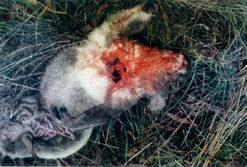 Strzelecki Koala Endangered
(South Gippsland Victorian, Australia) Strzelecki Koala Endangered
(South Gippsland Victorian, Australia)
.
<<Of major concern due to the logging and clearing activities of both Hancock Timber Resource Group and PaperlinX is the long term survival of populations of the Strzelecki and South Gippsland Koalas whose entire habitat is now owned by these companies.
An investigation carried out by Dr Bronwyn Houlden, School of Biological Science, University of New South Wales, 20th March 1997 and 6th April 1998 confirmed that the genetic pool of these koalas has not been compromised. Dr Houlden indicates that on a national basis koalas generally are not considered to be threatened. She advises that this assessment has unfortunately led to an extremely simplistic view of conservation of biodiversity in the species.
Through extensive analysis by herself and her collaborators she has revealed that the species is composed of highly differentiated populations with low levels of gene flow between populations throughout their range. The Strzelecki Koala population constitutes a separate management unit and is significant in terms of management of biodiversity on a regional and state basis. Dr Houlden found that the Strzelecki Ranges had the highest level of genetic variation, of any Victorian population she has analysed. This is important, given the low levels of genetic variability found in many populations in Victoria, which have been involved in the translocation program.>>
.
[Source: ‘Strzelecki Koala Endangered’, Hancock Watch (conservation group), ^http://hancockwatch.nfshost.com/docs/koala.htm#content_top]
.
.
The Critical Habitat Truth behind Hancock Timber Resource Group
.

Foreign-owned and controlled Hancock Timber Resource Group, claims publicly that its Victorian timber plantation operation, Hancock Victorian Plantations (HVP) is committed to…
“environmental responsibility is underpinned by the company’s environmental policy and management system, forest stewardship program, best management practices, which include internal and external performance measures, and active community consultation program, working with groups such as Landcare, field naturalists and Waterwatch.”
.
Hancock Victorian Plantations claims…
“HVP sets its own high standards, its operations are monitored by local shires, water catchment management authorities, the Environment Protection Authority (EPA) and the Victorian Department of Environment and Sustainability. The company is also subject to regular audits to maintain its Australian Forestry Standards (AFS) and Forest Stewardship Council (FSC) certifications.”Around 70 per cent of HVP’s total landholdings are sustainably-managed plantations, growing largely on land that was previously cleared for farming. The company maintains the remaining 30 per cent of its holdings for plantation protection, conservation and other community values.In the Strzelecki Ranges, HVP has set aside almost half of its land from timber production, managing this native forest for conservation.”
[Source: ^http://www.hvp.com.au/environment-conservation]
.
Editor: It all sounds wonderful coming from this United States industrial logger. But since when has anyone trusted US corporations? Read the snapshot log below.
.
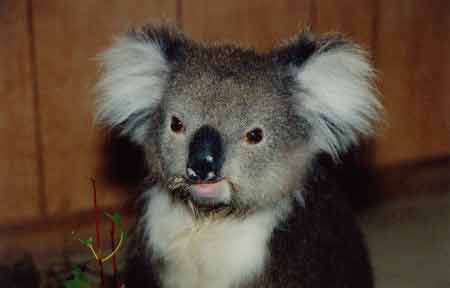 Road hit female koala with broken jaw. Had to be euthanised after 6 weeks.
Urgent research is required to determine breeding populations, location and numbers. Logging seriously impacts on long term populations of this animal.
[Source: Hancock Watch, ^http://hancockwatch.nfshost.com/docs/koala.htm#content_top] Road hit female koala with broken jaw. Had to be euthanised after 6 weeks.
Urgent research is required to determine breeding populations, location and numbers. Logging seriously impacts on long term populations of this animal.
[Source: Hancock Watch, ^http://hancockwatch.nfshost.com/docs/koala.htm#content_top]
.
.
Snapshot of a month’s logging of Koala Habitat:
[Source: ^http://hancockwatch.nfshost.com/docs/04sep.htm ]
.
South Gippsland, Victoria (October 2002) – systematically being destroyed for corporate profit by United States multi-national ‘Hancock Timber Resourse Group’:
.
Jeerlang West Road Strzelecki Ranges
- Locals outraged by removal of native vegetation – Koala Feed Trees. Koala corridor destroyed. Koalas are now not sited in this area. 8 Koalas have died in this area in the last 12 months.
.
Strzelecki Ranges (Jeeralangs)
- Eucalypts globulus – Bluegum (4ssp.) Southern Blue Gum – subspecies globulus. Restricted on the mainland to South Gippsland and Otways. Road works resulted in logging of older trees. Prime koala habitat destroyed by Grand Ridge Plantations/Hancock. A recent change in management will hopefully result in the end of this type of practice.
.
Strzelecki Ranges (Jeeralangs)
- Prime koala habitat destroyed without permit application by Grand Ridge Plantations/Hancock. Destruction of the rare Globulus globulus.
.
93-41 Creswick plantations
- Creek crossing over Anderson’s Gully which feeds into Creswick Creek. Tullaroop Water Catchment. Drinking water for Maryborough, Carisbrook, Talbot, Adelaide Lead, Alma, Havelock, Majorca and Betley. Sediment enters waterways mainly via creek crossings and roads.
.
93-41 Petticoat Plantation
- Tributary of Anderson’s Gully in the headwaters of the Murray Darling Catchment (Loddon River). Logging machinery driven straight through creekline.
.
93-41 Petticoat Creek
- Closeup of machinery entering tributary of Anderson’s Gully in the Tullaroop Water Catchment. Note build up of sediment which will wash into gully after rain. Note also buildup of stagnant water.
.
93-41. Petticoat Plantation
- Tullaroop Proclaimed Water Catchment. Machinery access into Anderson’s Gully tributary.
.
Morwell River East Branch/Strzelecki Ranges
- Creek crossing with sediment washing into waterway. Note also Slender Tree Fern an FFG listed species. Australia’s first FSC Assessment team in the Strzelecki Ranges. Discussing roading/landslide issues in the Jeerlangs.
.
Traralgon Creek in the Latrobe River catchment (Strzelecki Ranges)
- Recent pine logging with limited bufferzone in a pine plantation by Grand Ridge Plantations/Hancock. As part of the Friends of the Gippsland Bush/Australian Paper Agreement of 1997, 50 m buffers of native vegetation will be established along Traralgon Creek after pine logging. There were also problems with a creek crossing at this location, which can be seen eroding into the creek in this photo.
.
Tributary of Jeeralang Creek with cool temperate rainforest (Strzelecki Ranges)
- A Myrtle Beech tree is in the centre of the gully. The person in the photo is holding a twig with Myrtle Beech leaves taken from the base of a tree in the gully. According to the 1997 8 Point Agreement 50m buffers along Jeeralang Creek will be replanted with indigenous species. This area should not have been logged at all. Cool Temperate Rainforest needs much greater buffer for its long term protection and survival.
.
Jeeralang West Road
- (Non-plantation) Blackwood and Austral Mulberry cut down along roadside easement which is Crown Land. Logged by Grand Ridge Plantations/Hancock.
.
Billy’s Creek Catchment/Strzelecki Ranges
- Twenty metre buffer should be reinstated at this site as in accordance with Billy’s Creek Water Supply Catchment, Plan no 1870. (Ideally the entire slope should be retired from timber production due to its steepness).
.
Billy’s Creek catchment/Strzelecki Ranges
- 20m buffers should be reinstated in this plantation area.
.
Jumbuk Road/ Strzelecki Ranges
- Logging of roadside buffers/easements. Wildlife corridors destroyed at this site as well as the head of a gully feeding into Billy’s Creek.
.
93-29 Scarsdale Plantation (Woady Yaloak catchment)
- What is the long term impact on water yield from pine plantations in this catchment?
.
93-41 Petticoat plantation (Headwaters of the Murray Darling catchment [Loddon River])
- Tullaroop Water catchment is currently at 30% of its capacity due to primarily to drought. Hancock logged 223ha of pine in this catchment in 2001/2. Much of the land within the Creswick State Forest has in the past been affected by gold mining activities. Stabilisation of the worst affected areas was achieved with softwood plantations. Will sediment from these mining sites be disturbed by current plantation logging. Tullaroop catchment supplies towns such as Maryborough with drinking water. What is the impact of logging on water quality and quantity in this catchment?
.
Korweinguboora Reservoir catchment.
- Recently logged by Hancock. Note lack of buffer zones for this wetland feeding into the Reservoir. This reservoir supplies Geelong and other towns with drinking water.
.
Korweinguboora catchment (Geelong’s water supply)
- How can Hancock guarantee that herbicides and fertilser residues will not enter Geelongs water supply? Note lack of buffers surrounding this drainage line.
.
A tributary of Creswick Creek in the Tullaroop Water supply catchment
- Note lack of creek buffer zones and ripping of soil into creek banks. Will herbicide residues enter water from this site? What impact will operations at this site have on quality of water for all species including people? Is this sustainable?
.
Tributary of Creswick Creek in Tullaroop water supply catchment
- Over 200 ha of pine plantations in this catchment were logged in 2001/2. What is the long term effect of fast rotation plantations on water quality and quantity? Pines cut out of creek itself and creek banks at this site.>>
.
.
Bligh Labor Government flogs off Queensland’s forests for $603M to Hancock
.
[Source: ‘State sells off Forestry Plantations Queensland for $603 million to Hancock Queensland Plantations’, AAP, 20100518, ^ http://www.couriermail.com.au/business/state-sells-off-forestry-plantations-queensland-for-603-million-to-hancock-queensland-plantations/story-e6freqmx-1225868108050]
.
.
<<The Queensland Labor government has announced the sale of Forestry Plantations Queensland – the first transaction in its controversial asset sales. Treasurer Andrew Fraser said the 99-year licence for the timber plantation business would be sold for $603 million to Hancock Queensland Plantations. The sale price is well in excess of the $500 million that had been anticipated. Mr Fraser said he signed the contract on Tuesday morning.
“By reaching agreement on a price of $603 million, this exceeds original expectations and is great news for Queensland taxpayers,’‘ Mr Fraser told state parliament on Tuesday. “This is the first of the five commercial businesses to be sold, licensed or leased to the private sector, as the government reforms the state balance sheet and builds a stronger Queensland economy.”
He said award staff would have their jobs guaranteed for three years. Mr Fraser said Hancock Queensland Plantations, a company managed by Hancock Timber Resource Group on behalf of institutional investors, had won the right to grow and harvest the trees.
Crown plantation land on which the majority of the business sits will remain in government ownership. The sale includes about 35,000 hectares of freehold land, which is about 10 per cent of the total estate.
Hancock Timber Resource Group manages more than two million hectares of timberlands worth approximately $US8.5 billion ($A9.7 billion) across the United States, Brazil, Canada, New Zealand and Australia.>>
.
.
NSW Government accused of logging Koala Habitat
[Source: ‘NSW govt accused on koala habitat logging’, 20111118, ^http://news.ninemsn.com.au/national/8375719/nsw-govt-accused-on-koala-habitat-logging]
.
<<The opposition has accused NSW Environment Minister Robyn Parker of allowing the logging of koala habitats on the state’s mid-north coast. Opposition environment spokesman Luke Foley said the minister had received a “scathing” letter from the local councils protesting her decision to allow logging of core koala habitats in the area.
“These councils are traditionally pro-development – but even they are alarmed that Robyn Parker is allowing a national icon to be endangered thanks to her ‘unsound ecological approach’,” Mr Foley said in a statement on Thursday.>>
He said that…
On October 27 Ms Parker said “logging protects koalas”
.
Editor: Robyn Parker has not got a clue about her Environment portfolio. She is another teacher-turned-politician and clearly insecure. Last month Parker sacked the head of her department, Lisa Corbyn, and has been through five press secretaries.
The opposition’s environment spokesman Luke Foley: “When will Premier O’Farrell do the decent thing and get a new environment minister?”
[Source: ‘Controversial Environment Minister Robyn Parker creates a climate of change’, by Andrew Clennell, State Political Editor, The Daily Telegraph, 20120121, ^http://www.dailytelegraph.com.au/news/minister-creates-a-climate-of-change/story-e6freuy9-1226249892102]
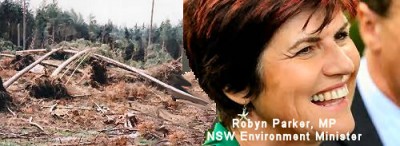 Embattled: Ms Parker – thinks she’s only accountable to herself and Premier O’Farrell.
Picture: Kristi Miller Source: The Daily Telegraph Embattled: Ms Parker – thinks she’s only accountable to herself and Premier O’Farrell.
Picture: Kristi Miller Source: The Daily Telegraph
.
.
New South Wales allowed logging in Koala Habitat
.
[Source: ‘NSW allowed logging on koala habitat’, by Rosslyn Beeby, Science and Environment Reporter, Canberra Times, 20110210, ^http://www.canberratimes.com.au/news/national/national/general/nsw-allowed-logging-on-koala-habitat/2072043.aspx]
.
<<The NSW Government has allowed 2,000 heactares of koala habitat to be logged at Coffs Harbour in northern NSW, despite a local koala conservation plan endorsed by the local council, a Senate inquiry has heard.
One of Australia’s leading koala researchers, Alistair Melzer, has accused federal environment bureaucrats of doing little to avoid ”an escalating conservation crisis” as koala populations decline.
Dr Melzer, who heads Central Queensland University’s koala research centre, told the Senate environment committee inquiry it appeared that Canberra’s bureaucrats ”do not seem to be sensitive to the real state of the environment”.
The six-month inquiry, into the conservation status and sustainability of Australia’s koalas, is investigating threats to the future survival of the species.
In his submission, former Coffs Harbour City Council deputy mayor Rod McKelvey said the NSW Department of Environment’s private native forestry division granted logging permits which resulted in the loss of 2000ha of ”core koala habitat” protected by the council’s koala conservation plan. Mr McKelvey said the department subsequently argued the plan ”did not fall under” NSW environmental planning policy.
”I do not want to be included in the generation who stood by and did nothing while we systematically destroyed koala habitat, making it almost impossible for them to live here,” he said.
Gunnedah farmer Susan Lyle, who has koalas on her three properties, raised concerns about a mining exploration licence issued for open-cut coal mining in the region.
”Our koalas will be decimated. This mining licence is primarily in isolation and to allow such a development is sheer lunacy … There are many, many other resources that can be used for energy, but there is no replacement for the koala,” she said.
.
.
Federal Forest Enquiry a Sham
.
[Source: ‘Federal Forest Inquiry a Sham’, 20111130, North East Forest Alliance, ^http://nefa.org.au/]
.
<<Conservation Group, North East Forest Alliance (NEFA), is outraged at the bias of the Federal House of Representatives report ‘Inquiry into the future of the Australian Forestry Industry’ and its refusal to consider the timber supply crisis and the over-logging of north-east NSW’s public forests.
NEFA spokesperson, Dailan Pugh, said that most of the evidence presented in NEFA’s 111 page submission was ignored by the inquiry on the grounds that it “criticised the industry”. “What they didn’t ignore they misrepresented. This pretend inquiry was a sham” he said.
“The Commonwealth is party to the North East Regional Forest Agreement (RFA) and claims that it satisfies its national and international obligations for the protection of world heritage, national estate and threatened species.
“While national heritage values were meant to be addressed as part of the RFA, they were not, so the Commonwealth gave the NSW Government an extra two years to complete the process. A decade later and there has still been no assessment and the Federal Government does not care.
“Similarly the RFA was meant to provide protection for nationally threatened species. The evidence we presented, such as the illegal trashing of a population of the nationally endangered fern Lindsaea incisa at Doubleduke, that was meant to be protected by a 50m buffer, was ignored because we were being ‘critical’.
“What is most astounding is that the inquiry refused to consider the evidence we presented on the current timber supply crisis due to the over-commitment of wood from north-east NSW’s public forests.
“Ever since new Wood Supply Agreements for timber from public land were given to sawmillers in 2004 Forests NSW have not been able to supply the committed volumes,” Mr Pugh said.
“The NSW Government’s recklessness in issuing these new Wood Supply Agreements has already cost taxpayers millions of dollars to buy back committed volumes and to compensate BORAL for Forests NSW’s failure to supply. As the crisis worsens, taxpayers exposure to multi-million dollar compensation claims grows.
“In vain efforts to meet shortfalls and reduce their payouts Forests NSW have been over-logging plantations, cutting trees before they mature, increasing logging intensities, logging stream buffers, and logging trees and areas required to be retained for threatened species. They are cutting out the future of the industry and causing immense environmental harm in the process.
“It is appalling, that an inquiry dealing with forestry has completely ignored this crisis and recommended that the Commonwealth Government condone and support this grossly unsustainable and irresponsible logging.
“Local Page MP, Janelle Saffin features in the inquiry’s report despite her electorate being one of the worst affected by the timber supply crisis, rampant illegal logging and widespread forest dieback.
“We call upon Janelle to please explain why the Commonwealth continues to ignore the gross over-logging, fails to identify and protect national heritage values, refuses to take action on the illegal logging of the habitat of nationally threatened species and refuses to consider the dieback of tens of thousands of hectares of public forests in her electorate. She needs to tell her constituents what she is going to do about it”” Mr. Pugh said.>>
.
.
South East Forest Rescue cranking it in south-east NSW
.
[Source: ‘South East Forest Rescue cranking it in south-east NSW’, 20120118, ^http://www.thelaststand.org.au/tag/southeast-forest-rescue/]
.
<<South East Forest Rescue have taken some crackerjack action this morning, halting forestry operations with a giant tripod and tree sit structure to highlight illegal logging in the Yambulla State Forest, south of Eden. The logging compartment where breaches have been identified by SEFR contains records of nationally listed endangered species such as glossy black cockatoos, smokey mice, southern brown bandicoots, tiger quolls, eastern pygmy possums, bent wing bats, yellow-bellied gliders, gang gang cockatoos and white-footed dunnarts.
“The response from Forests NSW shows the complete lack of regard for the licence conditions that Forests NSW and their contractors must abide by. The licence conditions for threatened species and habitat conservation are not being adhered to, even though the conditions are grossly inadequate” said forest campaigner Lisa Stone.
“We have reported the breaches in this compartment to the Office of Environment and Heritage,” said Ms Stone. “We stated last time that the probability of further breaches in this compartment if harvesting continues is high given that this logging contractor is a repeat offender and that FNSW still is not complying with the licence conditions” said Ms Stone.>>
.
.
‘NSW failing to protect koalas: Labor’
.
[Source: ‘NSW failing to protect koalas: Labor’, 20111027, AAP republished in the Sydney Morning Herald, ^http://www.smh.com.au/environment/conservation/nsw-failing-to-protect-koalas-labor-20111027-1mlnt.html]
.
<<The NSW Liberal government is failing to protect koalas by allowing logging in remaining habitats, the opposition says. Environment spokesman Luke Foley accused Environment Minister Robyn Parker of breaking an election promise to protect koalas after logging went ahead at the Bermagui State Forest on the south coast.
Logging also started last week at Boambee State Forest on the mid north coast, one of the last habitats for the vulnerable species in the area, Mr Foley said.
“For you to fail to respond and fail to intervene is a gross breach of your election policy to protect our national icon,” Mr Foley said at a budget estimates hearing in Sydney today. “Surely the precautionary approach would be for you as Environment Minister to stop the logging of this key koala habitat?”
Ms Parker denied breaking any election commitments, and said the government was working hard to protect koalas.
“When it comes to forestry, we are about getting a balance and protecting our native species. We are working very hard on them,” she said. “We have written to Forests NSW recommending a precautionary approach to managing impacts on koalas in the Boambee State Forest…The agreement that allowed logging to take place had been signed by the previous government, Ms Parker said. “Perhaps you should go back and look at what was going on when your government signed up to that agreement.”>>
.
.
Koala habitat cleared to make way for more houses
.
[Source: ‘Koala habitat cleared to make way for more houses’, 20121127 (today), by Nicole Fuge, Sunshine Coast Daily, ^http://www.sunshinecoastdaily.com.au/news/koalas-lose-vital-coast-habitat/1637085/]
.
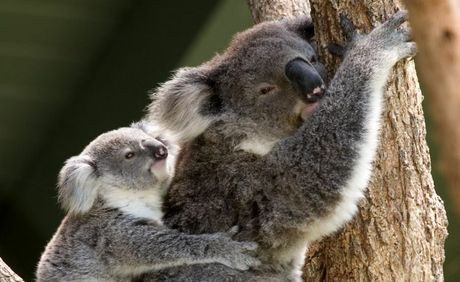
<<More than 100 hectares of koala habitat has been cleared to make way for more houses, another nail in the coffin for one of Australia’s icons.
Work has begun clearing the land behind Aussie World and the Ettamogah Pub for a 334-lot rural residential development.
Despite more than 30% of the 145-hectare site secured for environmental reserve and 12 hectares of revegetation to offset present clearing, Sunshine Coast Koala Wildlife Rescue volunteer Ray Chambers fears it’s not enough.
Mr Chambers said the area’s koala population was already fragile and the removal of so many trees would have a disastrous affect.
“We do have the odd koala in part of the Palmview area, it’s not a great deal but we know they are there,” he said. “From Forest Glen to the Caloundra turn-off is a koala corridor.”
.
Mr Chambers said there were only about 100 koalas left on the Coast, representing 18% of the Queensland population.
.
A council spokeswoman said despite approval of the development pre-dating an introduction of state-wide regulatory provisions for koala conservation, the council and Department of Environment and Heritage Protection officers had enforced koala protection measures and vegetation offsets.
Developer guidelines include:
- More than 30% of the original site secured in environmental reserve.
- Traffic calming, speed bumps, and fauna under and overpasses installed to minimise car strikes.
- Building envelopes to be enclosed with dog-proof fencing, leaving the balance of each lot free for fauna movement.
- About 12ha of revegetation, including planting koala food trees, to be carried out to offset the clearing.
The spokeswoman said a fauna spotting catcher had also been present during clearing.>>
..
Ed: What chance do Koalas have?
.
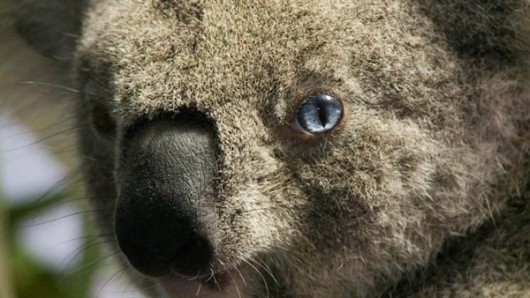 [Source: National Geographic, ^http://natgeotv.com.au/tv/koala-hospital/gallery.aspx] [Source: National Geographic, ^http://natgeotv.com.au/tv/koala-hospital/gallery.aspx]
.
Tags: Australia, Forests NSW, Government Loggers, Koala, koala extinction, koala habitat, New South Wales, NSW Forest Agreements, South East Forest Rescue
Posted in Gippsland (AU), Koalas, South East Corner (AU), Threats from Deforestation | 2 Comments »
Add this post to Del.icio.us - Digg
Friday, November 2nd, 2012
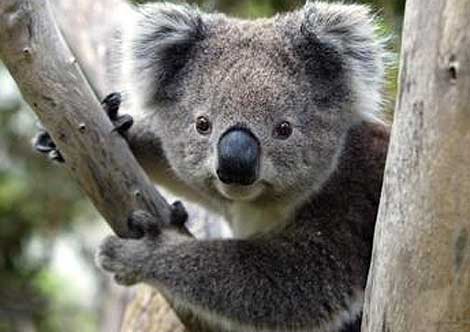 Once were common – now pose for the commoner! Once were common – now pose for the commoner!
Australia’s Koala
(Phascolarctos cinereus)
.
Australia’s iconic and once prolific Koala is now nationally listed as vulnerable to extinction.
What a despicable indictment of Australians!
<<The Koala was formerly common throughout the broad band of forests and woodlands dominated by Eucalyptus spp. extending from north Queensland to the south-eastern corner of mainland South Australia, Australia (Maxwell et al. 1996). However, the overall distribution of Koalas has been reduced since European settlement. This decline was primarily due to disease, bushfires, and widespread habitat destruction in the early decades of the 20th century.
Commercial poaching of koalas (they called it ‘harvesting‘) took place across the range towards the end of the 19th century and early 20th century (huge numbers, running into the millions, were killed for their pelts for a large export industry in Victoria, New South Wales, and Queensland). Koalas were widely hunted during the 1920s and 1930s, and their populations plunged.>>
Backward Queensland was the worst offender. In August 1927, the Koala fur trade saw the Queensland Government declare ‘open season’ on Koalas. Some 600, 000 koalas were shot to make gloves and hats in jut one month. It became known as ‘Black August‘.
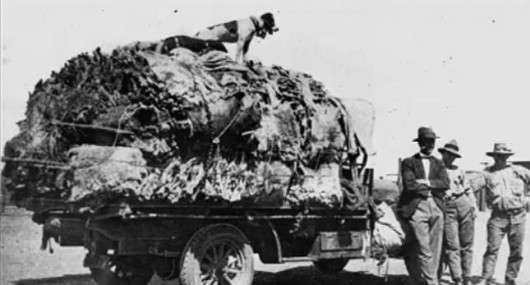 1927 ‘Black August’
When 600,000 Koalas were shot and skinned across Queensland
1927 ‘Black August’
When 600,000 Koalas were shot and skinned across Queensland
.
Commercial hunting was banned in Victoria in the 1890s, yet it continued sporadically (and under regulation) in backward Queensland until 1927 (Hrdina and Gordon 2004).

<<The Koala currently ranges from northeastern, central, and southeastern Queensland with patchy populations in western areas, to eastern New South Wales including the coastal strip and highlands of the Great Dividing Range, the western plains and related riparian environments where suitable habitat occurs, Victoria, and southeastern South Australia. The geographic range has contracted significantly due to loss of large areas of habitat since European settlement. In Queensland, extent of occurrence and area of occupancy have contracted by about 30% (Gordon et al. 2006).
Helped by reintroduction, Koalas have reappeared over much of their former range, but their populations are smaller and scattered. Koalas need a lot of space—about a hundred trees per animal—a pressing problem as Australia’s woodlands continue to shrink.>>
[Sources: The IUCN Red List of Threatened Species – Phascolarctos cinereus (Koala), ^http://www.iucnredlist.org/details/16892/0 ; ‘Koala’, National Geographic, ^http://animals.nationalgeographic.com/animals/mammals/koala/]
.
(2.6MB, pdf – NB. if slow to open, GoTo: File > Save As.., then open the PDF file from your auto-download folder)
.
[Source: The Decline in the distribution of the Koala in Queensland, G. Gordon, F. Hrdina, R. Patterson, Zoologist Vol 33, 2004,^http://www.rzsnsw.org.au/]
.
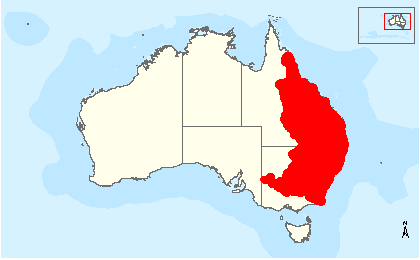 Koala Traditional Natural Range map (excluding Victorian and South Australia) Koala Traditional Natural Range map (excluding Victorian and South Australia)
[Source: ‘Koala (combined populations of Queensland, New South Wales and the Australian Capital Territory), Australian Government,
^http://www.environment.gov.au/cgi-bin/sprat/public/publicspecies.pl?taxon_id=85104]
.
<<Since European settlement, approximately 80% of Australia’s eucalypt forests have been decimated. Of the remaining 20% almost none is protected and most occurs on privately-owned land.>>
[Australian Koala Foundation, ^https://www.savethekoala.com/our-work/land-clearing-koalas]
.
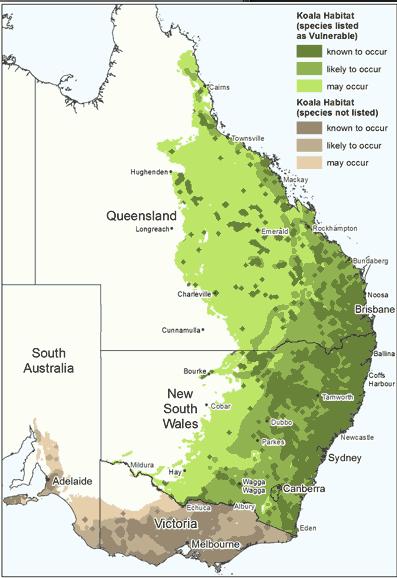 Koala reduced range map Koala reduced range map
Ed: Interpretation is Dark Green = known to occur, Light and Mid Green = used to occur
Dark green is where human population growth is worst!
(Source: ‘Koala (Phascolarctos cinereus) Listing’, Australian Government, 2012),
^http://www.environment.gov.au/biodiversity/threatened/species/koala.html]
.
.
Koalas partially listed as ‘Vulnerable’ to extinction
.
In April 2012, Australia’s Environment Minister, Tony Burke, declared that ‘at-risk’ koala populations along Australia’s eastern seaboard ‘vulnerable‘ under Australian national environment law – specifically under the Environment Protection and Biodiversity Conservation Act 1999.
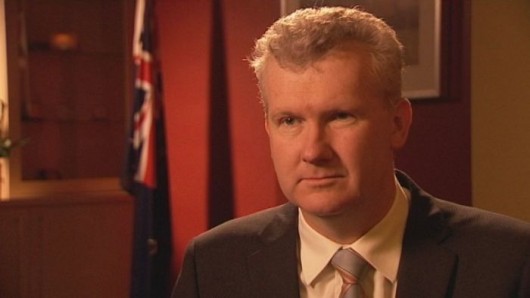 Australia’s Environment Minister, Tony Burke
Being interviewed on ABC Four Corners 20120821
[Source: ‘Koala Crunch Time’, ABC Four Corners, 20120821,^http://www.abc.net.au/4corners/stories/2012/08/16/3569231.htm] Australia’s Environment Minister, Tony Burke
Being interviewed on ABC Four Corners 20120821
[Source: ‘Koala Crunch Time’, ABC Four Corners, 20120821,^http://www.abc.net.au/4corners/stories/2012/08/16/3569231.htm]
.
This ‘EPBC Act‘ remains the Australian Government’s central piece of environmental legislation, providing a legal framework to protect and manage nationally and internationally important flora, fauna, ecological communities and heritage places. The Australian Government’s Department of Environment (etc) is currently developing EPBC Act referral guidelines for the Koala.
[Source: Australian Government, ^http://www.environment.gov.au/epbc/publications/interim-koala-referral-advice.html]
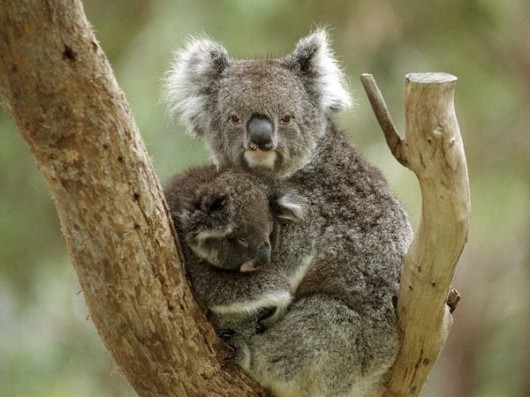 Koala with joey – zoo captive to benefit tourist visitation Koala with joey – zoo captive to benefit tourist visitation
[Source: Photo by Medford Taylor, National Geographic,
^http://animals.nationalgeographic.com/animals/mammals/koala/]
.
<<Rigorous scientific assessment by a variety of experts over the past three years has been reported back to Australia’s lead body on biodiversity conservation, the Threatened Species Scientific Committee (TSSC), which has found that Koala populations particularly in Queensland, New South Wales and Australian Capital Territory have declined markedly in recent years to a point where in these areas populations are vulnerable to regional extinction.
In 2011, the Threatened Species Scientific Committee combined available data for Koala populations across their natural range and generated estimates of the decline experienced over the period 1990–2010 by the national Koala population and, separately, the combined Queensland, NSW and ACT population (TSSC 2011bi).
The parameters of greatest uncertainty are the size of the Queensland population in 1990 and rate of subsequent decline, particularly in inland bioregions, and the size of the Victorian population.>>
The following table is a summary of the TSSC assessment of national Koala populations (TSSC 2012p):
| Region |
Date |
Best estimate |
Decline |
| Queensland |
1990 |
295 000 |
|
| 2010 |
167 000 |
43% |
| New South Wales |
1990 |
31 400 |
|
| 2010 |
21 000 |
33% |
| Victoria |
1990 |
215 000 |
|
| 2010 |
200 000 |
7% |
| South Australia |
1990 |
32 000 |
|
| 2010 |
19 500 |
39% |
TSSC 2012 Assessment of National Koala Populations
[Source: Koala (combined populations of Queensland, New South Wales and the Australian Capital Territory), Species Profile and Threats Database, Australia Government, ^http://www.environment.gov.au/cgi-bin/sprat/public/publicspecies.pl?taxon_id=85104]
.
<<These are the same regions where rapid ongoing housing development is allowed and encouraged, as Australia’s human population expands uncontrollably.
Mr Burke said “Koala populations are under serious threat from habitat loss and urban expansion, as well as vehicle strikes, dog attacks, and disease…In fact, in some areas in Victoria and South Australia, koalas are eating themselves out of suitable foraging habitat and their numbers need to be managed.”
“That is why the Scientific Committee recommended to me to list the Queensland, New South Wales and Australian Capital Territory populations as threatened, rather than to list the koala as nationally threatened across its full range.”
Mr Burke said the Gillard Government had committed $300,000 of new funding under the National Environmental Research Program Emerging Priorities to find out more about koala habitat.
“This funding will be used to develop new survey methods that will improve our knowledge of the quality of koala habitat using remote sensing, and help fill important data gaps to enhance our understanding and ability to protect the species,” Mr Burke said.
“The new funding is in addition to more than $3 million we have invested since 2007 to ensure the resilience and sustainability of our koala population.”>>
[Source: ‘Koala protected under national environment law’, The Hon Tony Burke MP media release, Minister for Environment etc, 20120430, ^http://www.environment.gov.au/minister/burke/2012/mr20120430.html]
.
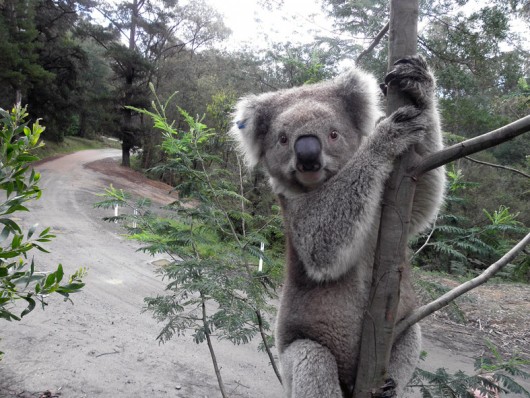 Koalas reduced to patchy populations
Below the IUCN radar/crisis, Koala functional extinction looms
… patchy populations, and more patchy every year.
Do we wait until Koala numbers downgrade to ‘Critically Endangered‘ before the Australian Government gives a toss! Koalas reduced to patchy populations
Below the IUCN radar/crisis, Koala functional extinction looms
… patchy populations, and more patchy every year.
Do we wait until Koala numbers downgrade to ‘Critically Endangered‘ before the Australian Government gives a toss!
[Source: ^http://home.vicnet.net.au/~fofkk/]
.
.
Australian Government – too little, too late, too selective
.
<<But the Australian Government’s announcement (back in April 2012, now six months ago) only confirmed what the Lismore-based ‘Friends of the Koala‘ group has known for more than a decade. Friends of the Koala volunteer carer Lola Whitney said the listing was long overdue.
“The work that we do here tells us that koalas are in danger of becoming extinct,” she said. “So many koalas come through our care centre every year, that it’s amazing we’ve got any around here at all. And the amount we lose from being hurt or from diseases – we lose a lot.”>>
.
Ed: But the Australian Government has only partially listed Koalas as vulnerable to extinction in Queensland, New South Wales and the Australian Capital Territory (ACT). Whereas Victorian and South Australian koalas were omitted.
.
This was because these were the recommendations of the 2011 Senate Enquiry, despite the TSSC confirmed 39% decline in the South Australian Koala population between 1990 and 2010.
.
Tony Burke as ultimate custodian: Why were problematic declining Koalas across South Australia and Victoria excluded from the EPBC Act?
.
It was also because the lead authority, the Threatened Species Scientific Committee, had “information gaps”, and because “the body of data on the status of koala populations is patchy, often sparse and not nationally comprehensive or coordinated”, the TSSC ignored the ‘Precautionary Principle and repeatedly rejected the Koala’s threatened species listing on the EPBC Act.
.
What it failed to appreciate was the more appropriate IUCN Red List categories of ‘DATA DEFICIENT’ (DD) and ‘NOT EVALUATED’ (NE).
.
.
The Conclusion by the 2011 Senate Committee Enquiry was selective. It read as follows:
.
<<The most prominent issue raised during this inquiry was whether the koala should be listed as a threatened species. Although the committee does not have the technical expertise of the TSSC, and therefore believes it is not qualified to determine whether or not the koala should be listed as threatened, the committee is deeply concerned about the sustainability of Australia’s koala population.
On one hand, the committee is pleased that the koala may not yet be eligible for listing as threatened. The committee believes that to have such a significant Australian icon
included on the threatened species list would be a national shame.
On the other hand, the committee believes there are parts of the koala population that require much greater protection. This is occurring to some extent in Queensland and NSW where the koala is listed in some areas under state environment protection legislation. However, state listing has not stemmed the marked decline in the population. If declines continue it will only be a matter of time before the koala is nationally listed as a threatened species.
The EPBC threatened species listing process is reactive and not well suited to the conservation needs of the koala. In the committee’s view, there ought to be processes available to enable proactive protection for the koala as well as other significant Australian species. In this regard the committee notes the possible mechanisms announced as part of the government’s response to the review of the EPBC Act which could enable a more proactive approach to koala conservation. Perhaps, building on the TSSC’s proposal to monitor species of cultural, evolutionary and/or economic significance, there ought to be a category of nationally significant species.
Ultimately, the committee would like to see Australia’s koala population return to plentiful numbers of healthy individuals, in resilient habitats, across the koala’s natural range.>>
[Conclusion, p. xix]
.
Threatened Species Scientific Committee repeatedly rejected Koala listing on EPBC Act
.
Three separate Listing Advices by the ‘ by the Threatened Species Scientific Committee (TSSC) to successive Australian Environment Ministers rejected the listing of the Koala as a threatened species on the EPBC Act, as follows:.
.
Feb 2006:
.
Due to the TSSC acknowledging that “there are still information gaps regarding the species’ conservation status“, the TSSC recommendation to Australia’s Environment Minister on Koala conservation was:
“The Committee recommends that the species Phascolarctos cinereus (Koala) is not eligible for inclusion in the list referred to in section 178 (Listing of Threatened Species) of the EPBC Act.”
[Source: ‘Advice to the Minister for the Environment and Heritage from the Threatened Species Scientific Committee (the Committee) on Amendments to the list of Threatened Species
under the EPBC Act’, 20060206, Item 6, p.15, Threatened Species Scientific Committee,^http://www.environment.gov.au/biodiversity/threatened/species/pubs/koala.pdf, >Read 2006 Listing Advice]
.
Sep 2010:
.
<<The body of data on the status of koala populations is patchy, often sparse and not nationally comprehensive or coordinated. The data quality is also variable. There has been only limited improvement in quality, relevance and integration of these data over the 15 years that the koala has been considered by this Committee and its predecessor. This situation is not unusual for the Committee but what is unusual is the huge area of occurrence and variability that the koala demonstrates. I addition there is a lack of any consistent reliable methodology for population monitoring of the koala.>>
.
<<In its deliberations, the Committee concluded that a Conservation Dependent listing for the koala could not be justified at this time.>>
.
[Source: Letter to Minster for Environment, by Associate Professor Robert J.S. Beeton, Chair, Threatened Species Scientific Committee, 20100930 ^http://www.environment.gov.au/biodiversity/threatened/species/pubs/koala-tssc-letter.pdf, >Read Sep 2010 Letter]
.
Feb 2011:
.
<<The Committee recommends that the list referred to in section 178 of the EPBC Act not be amended at this time by including the Phascolarctos cinereus (koala) in the list in the Vulnerable category.>>
.
[Source: ‘Advice to the Minister for Environment Protection, Heritage and the Arts from the Threatened Species Scientific Committee (the Committee) on Amendment to the list of Threatened Species under EPBC Act’, 20110211, Item 12, p.29, Threatened Species Scientific Committee,^http://www.environment.gov.au/biodiversity/threatened/species/pubs/koala-listing-advice.pdf, >Read Feb 2011 Listing Advice ]
.
Nov 2011 (change of heart, but ignoring Victoria and South Australia):
.
<<12. Recommendations
(i) The Committee recommends that the Minister declare the combined koala (Phascolarctos cinereus) populations in Queensland, New South Wales and the Australian Capital Territory to be a species for the purposes of the EPBC Act under s517 of the Act.
(ii) The Committee recommends that the list referred to in section 178 of the EPBC Act not be amended by including the koala (Phascolarctos cinereus) over its national extent.
(iii) The Committee recommends that the list referred to in section 178 of the EPBC Act be amended by including in the list in the Vulnerable category the combined koala (Phascolarctos cinereus) populations in Queensland, New South Wales and the Australian Capital Territory.
(iv) The Committee recommends that there should be a recovery plan for this species.>>
.
[Source: ‘Advice to the Minister for Sustainability, Environment, Water, Population and Communities from the Threatened Species Scientific Committee (the Committee) on Amendment to the list of Threatened Species under the EPBC Act, 20111125, Item 12, p.34, Threatened Species Scientific Committee,^http://www.environment.gov.au/biodiversity/threatened/species/pubs/197-listing-advice.pdf, >Read Nov 2011 Listing Advice ]
.
The current members of the Threatened Species Scientific Committee are:
.
- Professor Helene Marsh (Chair)
- Dr Guy Fitzhardinge
- Dr Gordon Guymer
- Professor Peter Harrison
- Dr Rosemary Purdie
- Dr Keith Walker
- Professor John Woinarski
- Dr Andrea Taylor
- Dr William Humphreys
- Dr Michelle Heupel
.
[Source: ‘Threatened Species Scientific Committee Members, Department of Environment (etc, Australian Govermment, ^http://www.environment.gov.au/biodiversity/threatened/committee-members.html]
 Professor Helen Marsh
TSSC Chair since August 2011 Professor Helen Marsh
TSSC Chair since August 2011
.
To his credit, Tony Burke had asked the Threatened Species Scientific Committee (TSSC) for more precise boundaries detailing areas where koala populations are in trouble.
In February 2012, Australian Koala Foundation chief executive officer Deborah Tabart said that this Senate Committee Enquiry document was telling Mr Burke that he should act now and not wait another 10 weeks.
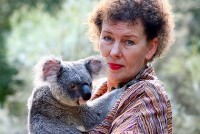 Deborah Tabart OAM
– not smiling Deborah Tabart OAM
– not smiling
.
<<“Minister Burke has delayed this decision, I think, twice and Minister (Peter) Garrett prior to that, I think, three times. “I’m just hoping that the Senate inquiry document, which is now firmly on his (Mr Burke’s) desk, should persuade him that, if nothing else, he should protect the koala under a precautionary approach”, said Tabart.>>
[Source: ‘Government ‘stalling’ on endangered koalas decision’, Feb 17, 2012, ^http://www.abc.net.au/news/2012-02-17/koala-listing-process-delayed/3835228 ]
.
[Source: Australian Parliament House, Senate Committees, >’The koala—saving our national icon’, 20110922, ^http://www.aph.gov.au/Parliamentary_Business/Committees/Senate_Committees?url=ec_ctte/koalas/report/index.htm]
.
<<The National Board of the Australian Koala Foundation (AKF), being much more aware of the Koala population range reality, undertook an extensive mapping project to quantify how many koalas remained in the wild, and where those koalas were located.
Extensive research was undertaken using National Vegetation Information System (NVIS) data, vegetation mapping, a bidling database of records for over 80,000 individually assessed trees from 2,000 field sites across the Koala’s range. Data has been collected by AKF from sixteen of the twenty-four Australian bioregions that the Koala is known to occur.>>
In 2011, the following map has been prepared estimating Australia’ national Koala population:
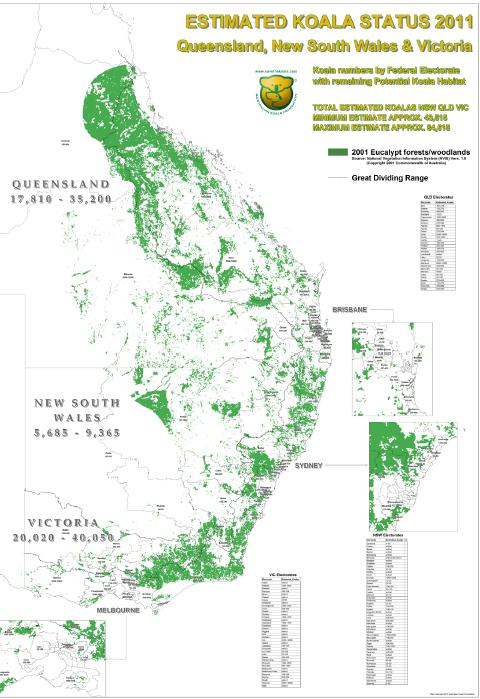 Estimated Australian Koala Population, 2011 Estimated Australian Koala Population, 2011
>Read Large Map(pdf) (3.4MB – – NB. if slow to open,
GoTo: File > Save As.., then open the PDF file from your auto-download folder)
[Source: ‘Bob’s Map’, Australian Koala Foundation,
^https://www.savethekoala.com/our-work/koala-numbers]
.
2011 Senate Committee: ‘The koala—saving our national icon’
.
The 19 Recommendations of the Senate Committee
.
<<Recommendation 1
The Australian Government fund research into the genetic diversity of the koala including a population viability assessment of the southern koala and determining priority areas for conservation nationally.
.
Recommendation 2
The Australian Government fund a properly designed, funded and implemented national koala monitoring and evaluation program across the full range of the koala.
.
Recommendation 3
The Australian Government establish a nationally coordinated and integrated program for population monitoring of threatened species and other culturally, evolutionary and/or economically significant species.
.
Recommendation 4
The Australian Government assist the koala research community and interested organisations to work towards a standardised set of methodologies for estimating koala populations.
.
Recommendation 5
The Threatened Species Scientific Committee provide clearer information to the Environment Minister in all future threatened species listing advices, including species population information, and that the Threatened Species Scientific Committee review its advice to the Minister on the listing of the koala in light of the findings of this inquiry.
.
Recommendation 6
The Australian Government undertake habitat mapping across the koala’s national range, including the identification of priority areas of koala conservation, with a view to listing important habitat under the provisions of the EPBC Act.
.
Recommendation 7
The habitat maps be used to identify and protect important habitat in known koala ranges.
.
Recommendation 8
The Australian Government review its land holdings which contain koala habitat and consider biodiversity, and specifically koala populations, in the management and sale of Commonwealth land.
.
Recommendation 9
The Australian Government actively consider options for recognition and funding for private land holders for the conservation of koala habitat.
.
Recommendation 10
The Australian Government fund research into koala disease, including the viability of vaccination programs and the effect of changes in leaf chemistry.
.
Recommendation 11
The Australian Government fund the Koala Research Network’s request for a Research Liaison Officer.
.
Recommendation 12
The Australia Government consider further wild dog control options in priority koala areas.
.
Recommendation 13
Local and state governments:
- Introduce appropriate speed limits in priority koala areas; and
- Where appropriate, build or retrofit underpasses or overpasses for major roads in priority koala areas as well as installing koala fencing adjacent to major roads.
.
Recommendation 14
Where the Australian Government provides funding for roads or other infrastructure in or adjacent to koala habitat, it be contingent on the provision of adequate koala protections.
.
Recommendation 15
The Australian Government work with the states to develop new national guidelines to ensure that all new roads and upgrades in or adjacent to koala habitat are koala-friendly.
.
Recommendation 16
The (Australian Government’s) Environment Minister consider the evidence provided to this inquiry when making his final decision on listing the koala as a threatened species.
.
Recommendation 17
The (Australian Government’s) Environment Minister consider options to improve the conservation status of the diverse and rapidly declining koala populations in New South Wales and Queensland to ensure a nationally resilient population is maintained. These options include listing the koala as vulnerable under the EPBC Act in areas where populations have declined significantly or are at risk of doing so.
.
Recommendation 18
An independent external review be conducted on the National Koala Conservation and Management Strategy to monitor the adequacy of progress. The review should assess and report on the progress made at the strategy’s midpoint.
.
The review must include an assessment of the:
- Strategy’s implementation to date and prospects into the future;
- Strategy’s effectiveness in stabilising koala numbers in areas of declining population, and in reducing the pressure of overabundant populations;
- Strategy’s level of ambition, including whether new elements are required; and
- Adequacy of the Commonwealth’s and the states’ respective roles and funding commitments.
.
Recommendation 19
The Australian Government adequately resource the National Koala Conservation and Management Strategy, and ensure that it is properly implemented through committing to a much stronger leadership role.>>
.
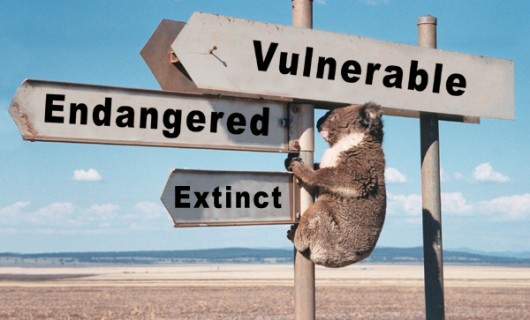 . .
.
Of note, ‘Recommendation 17‘ restricted the conservation status of the Koala only to ensure a ‘nationally resilient population is maintained’. That means that regional extinctions shall be acceptable, so long as a ‘nationally resilient population is maintained’ somewhere.
These are the places that the Koala is deemed to be declining and so given the vulnerable status. Other Koala populations elsewhere don’t weem to matter to the Australian Government.
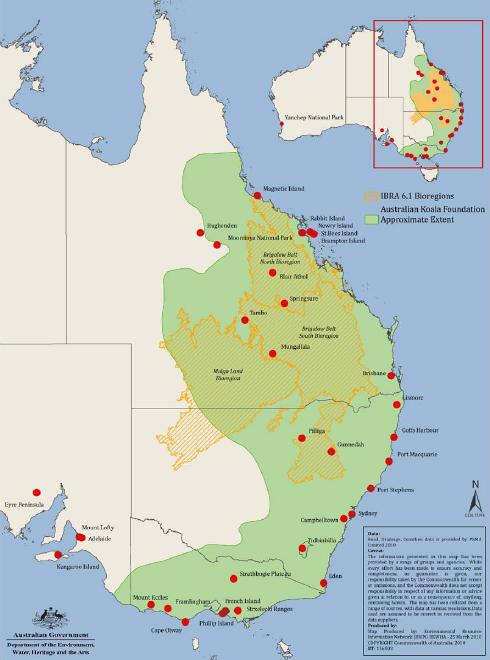 Koala tokenly listed as ‘Vulnerable’ but politically only at the above ‘selected places’
under the Environment Protection and Biodiversity Conservation Act (1999) Koala tokenly listed as ‘Vulnerable’ but politically only at the above ‘selected places’
under the Environment Protection and Biodiversity Conservation Act (1999)
.
.
2000: Even then, the United States recognised Koalas as ‘Vulnerable’
.
<<Back on 9th May 2000, the United States Government listed all koalas in Australia as vulnerable under the Endangered Species Act. The US Government determined that a) the eucalyptus and woodland ecosystems on which the arboreal marsupial depends has been greatly reduced, b) that despite conservation action by the governments of Australia, koala habitat continues to deteriorate, and c) that irrespective of koala numbers, the threats were present and real.
At the time, the Australian Government was outraged. The Australian Koala Foundation considered that the US may have been pointing out to Australia (when President Clinton and Vice President Al Gore were in power) that Australia needed to control its land clearing in readiness for the Kyoto Protocol on climate change. One petitioner pointed out that Australia at that time was clearing land second only to the Amazon.
At the time, the Victorian Government was pleading that they ‘had so many koalas they are pests’, and a similar cry was heard in the 2011 Senate Committee Enquiry into the plight of the Koala.
Australian Greens Leader, Senator Bob Brown had in 2010 successfully moved for a new Senate Comittee Enquiry to assess the threats to and management of koalas across the country. The Inquiry into the status, health and sustainability of Australia’s koala population, has particular reference to:
- the iconic status of the koala and the history of its management;
- estimates of koala populations and the adequacy of current counting methods;
- knowledge of koala habitat; d. threats to koala habitat such as logging, land clearing, poor management, attacks from feral and domestic animals, disease, roads and urban development;
- the listing of the koala under the Environment Protection and Biodiversity Conservation Act 1999;
- the adequacy of the National Koala Conservation and Management Strategy;
- appropriate future regulation for the protection of koala habitat;
- interaction of state and federal laws and regulations; and i. any other related matters.
.
Environment Minister Tony Burke appears to have been swayed by this plea as unlike his United States counterparts he did not consider the following in the American citation “…the actual number of koalas that were present at various times in the past and that may still exist is of much interest and helps to give some perspective but, as for many species, may not be the critical factor in determining whether the species is threatened. A low figure may reflect natural rarity of a population in marginal habitats. A high figure may be misleading if the entire habitat of the involved population faces imminent destruction”.
The document continues “…if we receive strong biological arguments, we would consider giving separate consideration to particular populations. It should be recognised, however, that koalas cannot be considered separate populations solely because they reside in different state jurisdictions”.
No such biological argument could be made. On the contrary, genetic studies in Victoria show that by and large all Victorian koalas, except those in the eastern part, are all pretty much genetically identical which means the future is bleak for conservation. Some of them even have testicles missing. On Kangaroo Island, some research suggests that as many as 29 per cent may have this affliction.
Imagine a koala that lives on the Murray River in New South Wales. On one side of the river, it has protection, but if it swims to Victoria, it does not. In AKF’s view, either the Australian Government values our national icon for its contribution to our nation or it does not.
As seen on Four Corners last night, the fur trade decimated the koala and the remnant populations are still low as a result of that slaughter.
Nowadays, the Koala pays its way in big tourism dollars, not the paltry one shilling (around 10 cents) per skin.
.
‘But the koala has powerful enemies. In the senate inquiry, developers, loggers, bureaucrats and even some departments of environment pleaded with the senators not to list the Koala because it would upset the developers or impede growth.’
.
The partial listing of the koala as vulnerable in NSW, ACT and Queensland can be seen as some sort of win, but will the existing legislation (the EPBC Act) be strong enough to protect the koala from long term destruction of its habitat?
Although the animal itself has been protected since 1936, its habitat really has not.
The Australian Koala Foundation believes its future lies in a koala-specific legislation similar to that of the American Bald Eagle Act, enacted in 1942. The Americans realised that if they did not do something strong and powerful they might lose their national icon forever. We believe that time has come now. The AKF estimates there may be as few a 43,000 koalas with no more than 85,000 left in its original habitat. If we are right, then there is no time to waste.
Greens Senator Bob Brown, as a final gesture before leaving Parliament, said he would support the AKF in our endeavours to enact a Koala Protection Bill. This should be a simple piece of legislation that basically says if you have koalas on your property that you cannot harm them, remove their trees and must – and that is the operative word – must ensure that your activity is benign for their long term future.
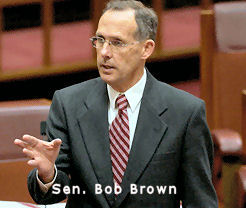
Four Corners has identified real threats to the koala and a partial listing will probably not make them go away. Neither will a specific piece of legislation, unless all our politicians actually realise we are at real risk of losing them.’>>
[Source: ‘Koalas deserve full protection‘, by Deborah Tabart, Chief Executive of the Australian Koala Foundation, 20120821, ABC, ^http://www.abc.net.au/environment/articles/2012/08/21/3571830.htm ; https://www.savethekoala.com/about-us/news-events/senate-inquiry]
.
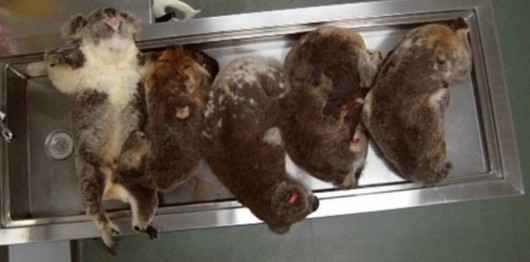 Dead Koalas on a vet’s autopsy table – with all the Green Talk how has it come to this?
Dead Koalas on a vet’s autopsy table – with all the Green Talk how has it come to this?
A native species that just sits up a tree, sleeps and hurts no-one
..now dying out because of Australian selfish viciousness.
Koalas are dying or being euthanised by the hundreds as a result of dog predation, road carnage, and Koala Habitat destruction.
[Source: ‘Koala Crunch Time’, ABC Four Corners (television programme), 20120821,
^http://www.abc.net.au/4corners/stories/2012/08/16/3569231.htm]
.
Watch ABC Four Corners Programme: ‘Koala Crunch Time‘
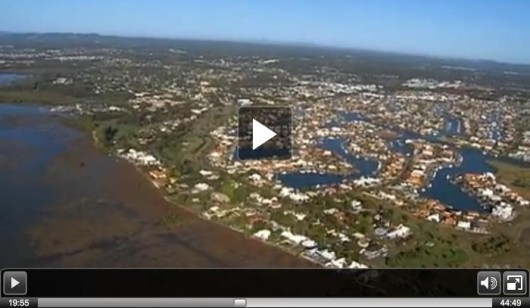 Australia’s Sprawl Profit overrules Biodiversity
‘Since 1997, koala hospitals along Australia’s eastern seaboard have recorded 15,000 Koala deaths’
[Source: Koala Crunch Time’, ABC Four Corners,^http://www.abc.net.au/4corners/stories/2012/08/16/3569231.htm] Australia’s Sprawl Profit overrules Biodiversity
‘Since 1997, koala hospitals along Australia’s eastern seaboard have recorded 15,000 Koala deaths’
[Source: Koala Crunch Time’, ABC Four Corners,^http://www.abc.net.au/4corners/stories/2012/08/16/3569231.htm]
.
 Westfield Shopping Centre development profiting out of Koala habitat apocalypse
Low (economic) Cost Housing, Coomera, Queensland Westfield Shopping Centre development profiting out of Koala habitat apocalypse
Low (economic) Cost Housing, Coomera, Queensland
.
.
IUCN wrongly continues to list Koalas as of ‘Least Concern’
.
Although Koala’s only exist naturally in Australia, at the international level the Koala (Phascolarctos cinereus) is still officially listed as of ‘Least Concern‘.
The most recent survey count of Koala status obtained by The International Union for Conservation of Nature (IUCN), the lead global authority on the environment and sustainable development, was back in 2008. Why, when the rapid decline data has been out since 2010?

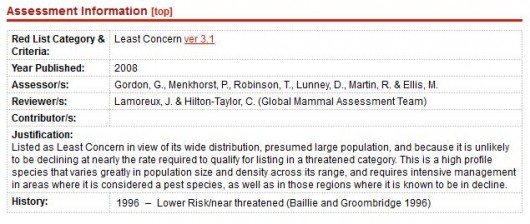 Phascolarctos cinereus (Koala)
The International Union for Conservation of Nature Red List of Threatened Species,
^http://www.iucnredlist.org/details/16892/0] Phascolarctos cinereus (Koala)
The International Union for Conservation of Nature Red List of Threatened Species,
^http://www.iucnredlist.org/details/16892/0]
.
The IUCN then assessed the Koala as having a ‘wide distribution’ and ‘a presumed large population’. It ignored regional declines and only regarded the national aggregate as appropriate data. Worse is that it stated thay the Koala “requires intensive management in areas where it is considered a pest species“.
Ed: What ecological incompetence, and wildlife hate would assess wildlife as a pest species?
.
The IUCN recognised that the Koala population was in decline in certain areas and identifed the following threats to the species:
- Continued habitat destruction, fragmentation, and modification (which makes them vulnerable to predation by dogs, vehicle strikes, and other factors)
- Bushfires
- Disease
- Drought associated mortality in habitat fragments
.
[Source: The IUCN Red List of Threatened Species – Phascolarctos cinereus (Koala), ^http://www.iucnredlist.org/details/16892/0]
.
Koala loss is symptomatic of Australia’s loss of much of the country’s native wildlife, its ecological communities and its biodiversity.
<<As of February 2011, a total of 1777 species are listed as threatened under the Environment Protection and Biodiversity Conservation Act (EPBC Act). A further 210 migratory and 464 marine species are also listed. The EPBC Act also lists 48 ecological communities as being threatened. These communities occur in a range of ecosystems including woodlands, forests, grasslands and wetlands.
Current threats to Australia’s biodiversity are:
- Habitat loss
- Degradation and fragmentation
- Invasive species and diseases
- Unsustainable use and management of natural resources
- Marine and coastal pollution (including from land based sources and vessels)
- Changes to the aquatic environment and water flows
- Changing fire regimes (Ed: bushfire management incompetence, and widespread Government-bush arson)
- Climate change.>>
.
[Source: ‘Status and Trends of Biodiversity’, Convention on Biological Diversity, ^http://www.cbd.int/countries/profile/?country=au#nbsap]
.
<<Friends of the Koala president Lorraine Vass said conservationists had been waiting for many years for koalas to be listed as vulnerable.
“At least a vulnerable to extinction listing,” she said. “It’s an additional layer of legislative protection and it’s better to have it than not to have it. “Apart from anything else it will be a very, very strong signal to everyone that at long last the nation is taking some responsibility for our national icon.”
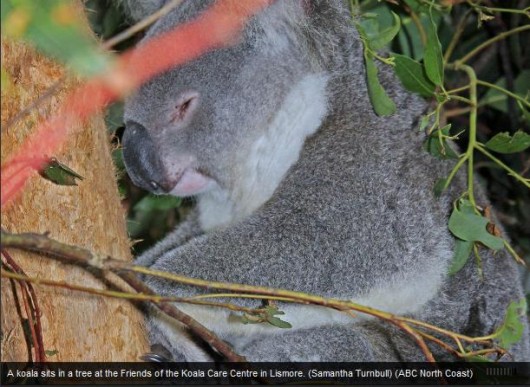
Ms Vass said statistics as well as anecdotal evidence showed koala numbers were rapidly declining, particularly in the Tweed (north eastern coastal New South Wales).
“I live at Wyrallah on a small property where koalas come and go, on the basis of observation at home I know that we’re seeing nowhere near as many koalas as we used to”, she said.
“In terms of statistics we’re actually bringing into care more koalas than we used to, but at the same time there are particular areas where we’re not bringing in as many koalas as we used to. So there are areas of local stress and the coastal area of Tweed is certainly one of those.”>>
[Source: ‘Greater protection for koalas‘, by journalist Samantha Turnbull, 20120430, ABC North Coast New South Wales, Australian Broadcasting Corporation, ^http://www.abc.net.au/local/photos/2012/04/30/3491805.htm, accessed 20121102]
.
<<This poor Koala was attacked by a Rottweiler in a suburban yard. It was reported that the koala was trying to get away and the dog grabbed it by the hindquarters as it was shimmying up a tree.
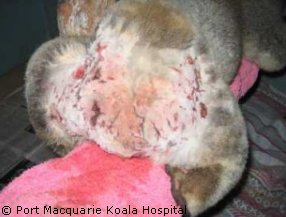 Koala injuries from a dog attack
Port Macquarie Koala Hospital
^http://www.koalahospital.org.au/ Koala injuries from a dog attack
Port Macquarie Koala Hospital
^http://www.koalahospital.org.au/
.
Sadly, this is a common occurrence with Koala’s. If it is not the hindquarters that are grabbed is around the neck or shoulder area. Usual injuries from this kind of incident are multiple puncture and tear wounds, with massive internal canine crush injuries. This koala had about 60 odd puncture wounds on his rump and groin area with many deep lacerations. His musculature around the groin and thigh area was lacerated pretty badly.
He died from shock, blood loss and ultimately a perforation of the intestine. The staff at the hospital gave him large amounts of fluids, and he was on strong painkillers and antibiotics. His wounds were flushed and he was kept in a warmed environment, but he died anyway.>>
[Source: Fourth Crossing Wildlife, ^http://www.fourthcrossingwildlife.com/dog_attack.htm]
.
.
Koala road deaths increasing
.
<<Not-for-profit conservation group, Friends of the Koala say 52 koalas were killed by vehicles on north coast roads last year.
The findings are part of the organisation’s annual report which documents the reasons behind the deaths of 222 north coast koalas. Association president Lorraine Vass says dog attacks and disease account for many koalas in their care. But she says hits from cars are the biggest concern.
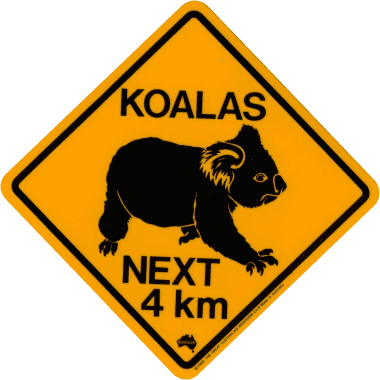
“One disturbing trend is an increase in road strikes,” she said. “Unfortunately that is a number that just keeps on increasing and last year we had 52 reports of koalas hit by cars. “Most of them, I’m afraid, were mortalities.”
But Ms Vass says there’s a positive outlook for koalas despite the figures. “I think there’s a lot to be optimistic about in terms of what’s going on with koala protection this year we’ve seen Lismore, we’ve got Tweed and Byron, those councils all working on a koala plan of management,” she said. “We’ve seen the federal announcement of the koala being listed under federal law as I say there’s a lot to be optimistic about.”>>
[Source: ‘Koala road deaths on rise‘, by Elloise Farrow-Smith, ABC, 20121019, ^http://www.abc.net.au/local/stories/2012/10/19/3614061.htm]
.
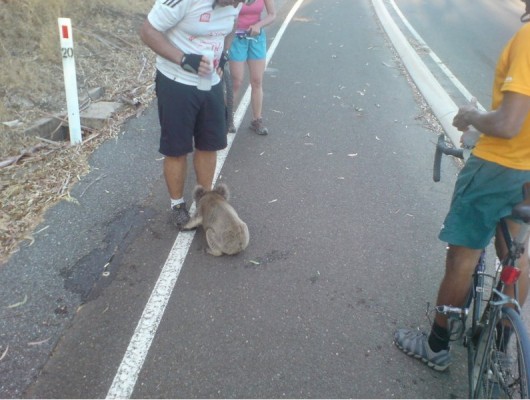 Koalas face a bleak future Koalas face a bleak future
.
Ed: The International Union for Conservation of Nature‘s global framework God-like governance for wildlife threatened by humanity is all about prioritising wildlife species most at risk of extinction for most protection.
.
It proclaims that if a species is not about to become extinct in the next ten years, its is not as important for conservation as those species that are.
.
But this is an Armageddon last man standing rationalisation. It may be administratively convenient, but it is an economic utilitarian philosophy that denies the rights of native wildlife to exist freely without persecution.
.
Were such an IUCN rationalist framwork applied to humans, such that don’t worry about say Chinese or Indians catching a deadly pandemic because there are a billion of them, it would be labelled as Herbert Spencer’s Social Darwinism or as Nazi Eugenics and quite rightly so. At The Habitat Advocate we espouse a worldview of Nature through: ^Deonteological Ethics and >Species Justice.
.
Every wildlife individual is valuable and has existence rights no different to humans.
.
Test: Would a human mother sacrifice her eldest or her youngest?
.
[Ed: All references sourced for this article 20111102]
.
.
Further Reading:
.
[1] ‘Koala Species Profile‘, Species Profile and Threats Database, Department of Environment etc, Australian Government, ^http://www.environment.gov.au/cgi-bin/sprat/public/publicspecies.pl?taxon_id=85104
.
[2] ‘Listing Advice to protect the Koala under the EPBC Act‘, Department of Environment etc, Australian Government,^http://www.environment.gov.au/biodiversity/threatened/species/pubs/197-listing-advice.pdf >Read Listing Advice (42 pages, PDF, 400kb – – NB. if slow to open, GoTo: File > Save As.., then open the PDF file from your auto-download folder)
.
[3] Koala Habitat Distribution Map (surveyed in 2011), Department of Environment etc, Australian Government, 2012 ^http://www.environment.gov.au/biodiversity/threatened/species/pubs/phascolarctos-cinereus-distribution-map.pdf
>Read Map (PDF, 300kb – NB. if slow to open, GoTo: File > Save As.., then open the PDF file from your auto-download folder)
.
[4] ‘Koala now threatened species‘, 20120215, Radio National Breakfast (radio programme), Australian Broadcasting Corporation,’There’s quiet optimism among koala experts that our national icon will finally be classified as a threatened or endangered species’.^http://www.abc.net.au/radionational/programs/breakfast/2012-02-15/3830832
>Play .mp3 audio:
 ℗ 2012 Australian Broadcasting Corporation ℗ 2012 Australian Broadcasting Corporation
.
[5] ‘Iconic animals – the koala‘, by Margot Foster, 20111228, ABC Rural (radio programme), Australian Broadcasting Corporation,
Abstract: ‘Michael Cathcart looks at the current efforts to protect this vulnerable animal. A senate committee has been looking into ‘the status, health and sustainability of Australia’s koala population’. He discovers the koala’s role as a cultural icon and the impact on our awareness of the koala, made by Norman Lindsay, as well as Dreamtime representations of the koala which reveal a great deal about the unique physiology and habits of this elusive animal.
The history of extensive slaughter of the koala since white settlement, because of the quality of its fur and value abroad, is an irony today because on Raymond Island, East Gippsland, koalas are making too many babies. There are about three hundred koalas on the small island and Department of Sustainability and Environment wildlife manager Charlie Franken says that’s about 250 too many.
Michael Cathcart speaks with Deborah Tabart OAM, CEO of the Australian Koala Foundation; Ann Moyal, author Of “Koala: A Historical Biography”; Michael J Connolly, Munda-gutta Kulliwari, Dreamtime Kullilla-Art; Helen Glad, Norman Lindsay’s grand daughter; Ann Moyal, author and historian; Charlie Franken, wildlife manager, Department of Sustainability and Environment; Dr Jay Patterson, Melbourne zoo vet and Dr Grant Kuseff, Bairnsdale veterinary surgeon;
^http://www.abc.net.au/rural/telegraph/content/2011/s3390776.htm
>Play .mp3 audio (large data file so may take a minute):
 ℗ 2011 Australian Broadcasting Corporation ℗ 2011 Australian Broadcasting Corporation
.
[6] ‘Interim koala referral advice for proponents‘, June 2012, Department of Environment (etc.), Australian Government,
Abstract: ‘Koala (Phascolarctos cinereus) populations in Queensland (QLD), New South Wales (NSW) and the Australian Capital Territory (ACT) have been listed as vulnerable under the Environment Protection and Biodiversity Conservation Act 1999 (EPBC Act). This listing came into legal effect on 2 May 2012. The listed threatened QLD, NSW and ACT populations are hereafter referred to in these guidelines as the koala.’
^http://www.environment.gov.au/epbc/publications/pubs/bio240-0612-interim-koala-referral-advice.pdf
.
[7] Australian Koala Foundation, ^ https://www.savethekoala.com/
 . .
[8] Koala Hospital, Port Macquarieuth Wales, ^ http://www.koalahospital.org.au/
 . .
[9] IUCN. (2001). IUCN Red List Categories and Criteria: Version 3.1. IUCN Species Survival Commission. IUCN, Gland, Switzerland and Cambridge, UK. ii + 30 pp, ^ http://www.iucnredlist.org/documents/redlist_cats_crit_en.pdf , >Read Document
.
Tags: Australian Koala Foundation, Black August, endangered koalas, Environment Protection and Biodiversity Conservation Act, Estimated Australian Koala Population, Friends of the Koala, Greater protection for koalas, iucn, Koala, Koala Crunch Time, koala extinction, koala habitat, Koala Protection Act, Koala Protection Bill, Koala road deaths, Koala road deaths on rise, National Koala Conservation and Management Strategy, New South Wales, Phascolarctos cinereus, Queensland, Save the Koala, Senate Committee Recommendations, South Australian koalas, The International Union for Conservation of Nature, The koala—saving our national icon, Threatened Species Scientific Committee, Victorian koalas, Westfield
Posted in Koalas, Threats from Development | 2 Comments »
Add this post to Del.icio.us - Digg
Tuesday, March 30th, 2010
by Editor 2010330.
The New South Wales government logging agency, euphemistically named ‘Forests NSW’, has ongoing plans to log old growth native forests through the South East Corner bioregion of NSW. These forests provide rare and important habitat for Australian fauna, some of which in this region are now critically threatened with extinction due to the logging, burning and deforesting activities of Forests NSW, the National Parks Service under its parent which changes its name every frew years, and the NSW Rural Fire Service.
Australia’s SE Corner (SEC) Bioregion encompasses the shires of Eurobodalla, Bega Valley, Bombala and parts of Cooma-Monaro and Snowy River. The South East Corner forests include the Tilba, Bermagui, Murrah, Mumbulla, Tanja and Wapengo State Forests . It also includes a number of national parks including the Biamanga National Park.
Not surprisingly, many Australians, and particularly locals in this bioregion, value these forests being protected and are opposed to the habitat destruction being wrought to the old growth forests. Key active environmental organisations seeking to protect these forests include the Friends for Five Forests and the South East Region Conservation Alliance Inc. (SERCA). SERCA is an umbrella organisation for conservation, environment and for citizens’ groups who want to conserve and protect the natural environment of South East NSW, Australia. SERCA’s member organisations include Bega Environment Network | Chipstop | The Coastwatchers Association Inc | Colong Foundation for Wilderness | Friends of Durras | National Parks Association – Far South Coast | Natural Native Forests | SE Forest Rescue | Yurangalo Inc.
SERCA formed in September 2005 to ’maximise efforts and resources’ of these organisations to combat the continued NSW Government-sanctioned woodchipping of native forests, to participate in formal environmental planning by the NSW Government in the regionprocesses and importantly to protect these forest habitats from damaging development and land and forest management practices.
Below is a series of reports on the events affecting these forests from these various organisations and from media reports up until March 2010.
Forests NSW have moved into log the Mumbulla State Forest
SOURCE: Friends for Five Forests, 20100329, http://www.fiveforests.net/
29 March 2010:
‘Forests NSW have moved into Compartments 2133 and 2135 in Mumbulla State Forest.
‘After a local resident photographed koala prints on Lizard road, near Cpt 2163 next on the logging list, the DECCW have apparently decided to undertake surveys before their burning operation on the other side of the road.
‘Much of the forest in Mumbulla creek catchment of Biamanga NP is growing on the Murrah soil landscape – still the only place koalas have been located. On this basis and in combination with the State Government’s management, the species remains endangered and likely to become extinct.’
Tanja State Forest – local residents meeting with State Forest reps.
Richard Blakers, 20100322 http://www.serca-online.org/our_media_releases/2010/Blakers22.rtf
22 March 2010:
‘Residents shocked by scale of proposed logging in Tanja State Forest Local residents met with State Forest representatives last week to discuss proposed logging operations in Tanja State Forests.’
‘The residents thanked the State Forests representatives for meeting with them and listened carefully to the information they provided. However, residents are very unhappy with the outcome of the meeting. They were shocked to discover the scale and intensity of the proposed logging and are not satisfied with State Forest responses to any of the concerns raised.’
‘The areas to be logged lie between Bega and Tathra along the north side of the Bega River. Near Mogareeka, the logging comes to within 50 metres of the river. It is also along the eastern side of ReedySwamp Road and extending along all the ridges and down to within 15 -20 metres of the drainage lines and creeks draining into the Bega River.’
‘The State Forests representatives explained steps taken to protect water quality, wildlife and scenic values in the logging operations. However it was clear that the measures are the barest minimum and worked out to allow for maximum tree removal, not maximum protection of other forest values.’
‘State Forests representatives conceded that after the proposed logging operation all available larger trees will have been removed from the forest and it will be well over 100 years before similar trees will again be available for commercial logging.’
‘They also stated that the logging was being driven by their need to meet wood supply agreements, and that within 3-5 years this kind of logging would stop in the Southern Region Forests because the supply of older trees will be exhausted. Once this happened, the industry would restructure to be able to use smaller trees.’
‘State Forests acknowledged that this logging will have significant short and long term impacts on local residents, and suggested the solution might be for residents to question their decision to buy property adjoining state forest.’
‘Residents think this is not a helpful attitude that does not address any of their issues.’
‘The residents have legitimate concerns about what happening to the public forests around our towns and homes. State Forests representatives do not seem to be in any position to cater to the residents needs because they are under pressure to meet wood supply agreements.’
‘Residents are therefore demanding that the State Government bring forward plans to restructure the timber industry and place a moratorium on logging in these coastal forests. It is not reasonable that these areas of older forest that have significant values other than just timber production should be sacrificed in order to meet such short term
goals.’
Koala colony under threat
Source: ABC 7pm TV News NSW, 18 March 2010, http://www.abc.net.au/news/video/2010/03/18/2849958.htm
‘Environmental groups say State Government plans to commence logging in the Bega Valley, on the NSW far south coast, will decimate the local koala population.The last known population of koalas on NSW’s far south coast could be under threat by State Government plans to log their habitat.’
Forests NSW & RFS burn 700 ha of Biamanga NP
SOURCE: Friends for Five Forests, 20100329, http://www.fiveforests.net/
Early March 2010:
‘Working collaboratively the NPWS, Forests NSW and the Rural Fire Service [RFS] have decided to burn close to seven hundred hectares of Biamanga National Park.
‘It appears the timing of this operation is consistent with plans to begin unsustainable logging on Monday 29 March. Consequently the NPWS is proposing to close the Lizard road to reduce access to the logging area from the east.’
NSW Government report on koalas in Mumbulla State Forest is flawed
SOURCE: Friends for Five Forests, 201002, http://www.fiveforests.net/
February 2010:
‘The month ends with NSW government releasing a belated ‘interim’ report on the highly inefficient and non-adaptive/heuristic koala surveys. Amongst other disturbing elements the survey took 5 times as long to complete as the pilot survey. The cost to date, leaving aside the eight arrests and other time runs at over $1million, being twice the estimated value of all the sawlogs remaining in Mumbulla State Forest.’
‘The survey outcome, based on employing a 2% (?!) activity contour, is that less than 5% (1089 ha) of the area surveyed (22,000 ha) is said to be occupied by koalas. Regrettably there is some uncertainty about how this area has been derived as the RGB-SAT methodology measure for a single tree in a plot is 3.3%. There are no details as to how the 2% contour has been calculated although theoretically it should encompass a greater area than a 3.3% contour but this is apparently not the case.’
‘Seems to be another example of how the NSW and other governments put unsustainable logging above all else. On a positive note the genetic analysis demonstrates the NSW Scientific Committee was quite wrong.’
Loggers are set to destroy one of Australia’s last remaining koala habitats.
Source: John Hibberd, SERCA: http://www.serca-online.org/our_media_releases/sercamembers/Koala.pdf
February 2010:
‘The NSW Government has started sending contractors into the forests in South Eastern NSW. Negotiations between the NSW Department of Environment and the state government agency responsible for logging, Forests NSW, appear to have failed to reach a compromise.
‘The irony is that the NSW Government last year ordered a survey to try and find koalas in the coastal forests that are now about to be logged. The survey, which was conducted across all land tenures, found a small, active population of about 30 koalas and is continuing.
‘It seems the NSW Government has now decided its contractual obligations to supply saw logs locally and woodchips to Asia are more important then protecting this much loved native animal, which is immortalized in Australian culture.
‘The disease, Chlamydia, plus loss of habitat have contributed to a dramatic decline in koala numbers over recent decades, with the species now close to being declared endangered.
“Soon it will be too late to save the species.” Says Debora Numbers of koalas in Australia may be as low as 45,000 recent surveys by the Australian Koala Foundation show.
‘The koala population in South Eastern NSW was once healthy but in the last 100 years has been decimated by hunters interested in koala pelts and by logging.
‘Forests NSW have not publically given a date for the start of logging in the Mumbulla State Forest, no doubt expecting direct action from conservationists who forced loggers out of an area close by three years ago.
‘The issue will put heat on the new premier of the state of NSW, American-born Kristina Keneally, who was installed by the right-wing faction of the party recently.
‘And Commonwealth Minister for the Environment Peter Garrett – a former rock star with internationally successful band Midnight Oil and environmentalist – has been asked to intervene.
‘Steve Phillips – arguably NSW most experienced and expert Koala scientist, said on ABC radio recently,” We have got the management prescriptions (for koalas) wrong, especially in the SE …. The small area of koala habitat remaining is such a precious resource …. They have just got to be protected so they can continue to expand ….. there is no longer any argument about what is important habitat”.
‘NSW Minister for forestry Ian MacDonald stated in Parliament in 2008 that despite recurrent financial losses, logging in native forests will continue, in order to support jobs.
‘Yet billions of dollars of taxpayer funds have been pumped into plantations as replacement timber and fiber for industry and export. NSW Forests rely heavily on the outdated Regional Forest Agreements that were signed off in the late 90s giving new areas in National Parks to the state but retaining forests for logging. Conservationists say the industry is outdated and only propped up by political will and union backing.
‘These agreements are excluded from the Environment Protection Act (EPBC) as well as climate change and water supplies.
‘Will zoos soon be the only places to see koala? Will NSW Premier Kristine Keneally do her part and stop logging these coastal forests of Mumbulla, sealing the fate of these last few koala?’
‘It seems not despite 2010 being The Year of Biodiversity.’
Logging Plan Poses Threat to Precious Koala Colony
SOURCE: Friends for Five Forests, 20100124, http://www.fiveforests.net/ from Sydney Morning Herald.
January 2010:
‘The year begins with the NSW government deciding to support the (Japanese) native forest logging industry and their proposals to eliminate the last koalas. According to the Sydney Morning Herald: Forests NSW and the Department of Environment and Climate Change are “ . . . in search of a compromise between felling trees and maintaining enough forest to allow the koalas to survive.” (http://www.smh.com.au/environment/conservation/logging-plan-poses-threat-to-precious-koala-colony-20100124-msm7.html)
‘Referring to the Regional Forest Agreements the recently released independent review of the EPBC Act states “ . . . if the terms of the approval are not complied with, or if there is insufficient reporting information to verify that compliance, Dr Hawke recommends that the approval should be terminated.” And “ . . . the full protections of the Act should apply to forest activities.” In his press release Environment Minister Peter Garret stated:
“ . . . the Government notes the concerns raised by Dr Hawke in recommendation 38 in the review regarding the current mechanisms in the Act for forest management under Regional Forest Agreements (RFAs), and is committed to working with state governments to improve the review, audit and monitoring arrangements for RFAs, including their timely completion, clearer assessment of performance against environmental and sustainable forestry outcomes, and a greater focus on compliance of RFAs in the intervening years.”
‘The Government intends to use upcoming RFA renewal processes to improve the achievement of these outcomes in future RFAs. In light of this, the Government rejects the mechanisms proposed in recommendation 38 and does not propose to review section 38 of the EPBC Act as it currently applies to RFAs.” [Source: http://www.environment.gov.au/minister/garrett/2009/mr20091221.html]
The fact that the DECC are working with Forests NSW to ensure logging in the catchments suggests that they either remain unconvinced that logging spreads Bell-miners or they believe that koalas like sick trees. If the Commonwealth are committed to these ideas they should have no problems working with the state government.’
Forests NSW ignores koalas to permit logging of Mumbulla State Forest
SOURCE: Friends for Five Forests, 20100329, http://www.fiveforests.net/
December 2009:
‘With no apparent reason, other than to progress koala extinction the NSW Government is reportedly planning business as usual when work resumes in the New Year. This work has begun and the Department of the Environment for Climate Change (DECC) has deleted from their website all information about the koala surveys over the past 2 years.’
‘The NPWS Regional manager Tim Shepard is reported as saying “. . . now we have a good idea of where Koalas live . .” We are using this information to help us plan our hazard reduction programs”(Coastal Custodians, Nov/Dec 2009). Also, a rumour has spread from the Wapengo Watershed Association claiming Forests NSW will begin the year logging koala habitat in Mumbulla State Forest. While the source of this proposal remains unconfirmed, it does confirm some suspicions. Notably that logging is to be suspended at Bermagui so the negative impacts of uncontrollable wildfire in logging slash adjacent to the town, can be reduced over summer. Killing koalas is, apparently, OK.’
Logging begins in Compartment 2001 in Bermagui State Forest
SOURCE: Friends for Five Forests, 20100329, http://www.fiveforests.net/
‘Forests NSW have approved logging in 89% of the compartment as opposed to the maximum of 60% allowed for in their legal approvals. Desperate to maintain timber supplies this logging confirms the statement from Forests NSW manager Mr Martin Linehan that “We can do what we want when we want“.
‘Fifteen months after the NSW Government released a map that is inconsistent with the outcomes of the pilot koala surveys. Koala expert Dr Steve Phillips has been interviewed ABC local radio about the uncertain fate for koalas at a national level and the last few Five Forests koalas.’
Forests NSW Illegally Logging in Bermagui
SOURCE: Friends for Five Forests, 20100329, http://www.fiveforests.net/
September 2009:
‘Four arrests have been made as a result of Forests NSW claims, but examination of the operational map, the prohibited area notice and the logging plan(s) for Cpt 2002 demonstrate the logging is outside the IFOA. Critical koala habitat is being destroyed while the NSW police support Forests NSW illegal logging.’
‘Logging began in Compartment 2002 of Bermagui State Forest on Thursday September 10. The logging plans (download from resources page) for the compartment are not an accurate or honest representation of soil, flora, water or roads in the compartment. Details of concerns about the operations, also available on the resources page, have been passed onto the NSW police and NCS International.
‘Forests NSW can log this critical koala habitat on the only soil landscape known to have koalas because they have been able to abuse the process based on unproven claims about koalas in the south east.’
‘A community conducted review of the Eden Regional Forest Agreement (RFA) between the Commonwealth and NSW State Governments has found that forests in the southeast are being exploited at rate that far exceeds the limits of ecological sustainability and those of the relevant legislation.’
‘Community representative on the Forest Resources and Management Systems Committee for the Eden assessment process and review author Mr Robert Bertram believes that the RFA has failed to achieve the legislated ecological milestones and this failure has negative implications at local, regional and global levels.’
“ The review analyses Annual reports from the NSW Forestry Commission that indicate dramatically reduced timber yields of 60% for sawlogs and 40% for pulp logs and a massive escalation in areas being logged, such that over the past five years nearly 50% of all State forests in the Eden region have been scheduled for logging.’
“These outcomes confirm that extensive canopy dieback and the associated death of millions of trees in the southeast is having a significant impact on the native forest logging industry. It is apparent that some 50,000 hectares of additional forests have been covertly handed over to ensure wood supplies.’
“These additional forests include areas that the Forestry Commission failed to declare during the Eden assessment and vast tracts of forests on the tablelands, that have similarly not been assessed. It is apparent that these Crown forests are being logged with the assistance of significant public subsidies and at a rate that greatly exceeds the requirements of the RFA.
However, of greatest concern is that the RFAs are designed to ignore the science that explains the decline of eucalyptus forests and it’s relationship to timber supplies, species extinction, catchment degradation and climate change. It seems that Government departments and other publicly funded organizations are either threatened or ‘paid off’ to ignore or suppress relevant information. The success of the RFA has been to demonstrate that ignorance and greed has overcome credible science, accountability and intergenerational equity.”
‘The review entitled: ‘The effects of deforestation on timber volumes, areas logged and associated climate change issues: A community review of the EdenRegionalForest Agreement” can be downloaded at the Friends of the Five Forests website: http://www.fiveforests.net/resources
Forests NSW has compartment 2002 in the Bermagui State Forest on its worklist
SOURCE: Friends for Five Forests, 2005, http://www.fiveforests.net/
‘Friends of Five Forests and their supporters will have to mount yet another campaign to have the logging stopped if Black Lagoon and Meads Bay are to be protected in accordance with the sanctuary zone classification they have been given as part of the Batemans Marine Park, and if the very few remaining koalas are to have any chance of survival. This large compartment of predominantly spotted gums is a significant part of the catchment for Narira Creek and Black Lagoon, which link into Meads Bay.’
‘The Batemans Marine Park provides for the highest level of protection of Black Lagoon and Meads Bay as sanctuary Zones. Logging can be expected to lead to further serious siltation of the Creek, and to damage plant and fish life in both the Lagoon and Meads Bay. The Park Zone Plan does not come into operation until June 2007.’
‘Pre-emptive action by Forests NSW to log compartment 2002 in the interim would make a mockery of the Marine Park zoning.’
‘The compartment contains areas of significant koala habitat. It is also next to part of the Kooraban National Park that contains the only koalas in this immediate region. Both this area and compartment 2002 are occupied by the Five Forests koala population, which was nominated as endangered some years ago.’
‘NSW Government release of a report by consultants on a Koala Management Plan for the region is now well overdue.’
‘Friends of Five Forests and their supporters will have to mount yet another campaign to have the logging stopped if Black Lagoon and Meads Bay are to be protected in accordance with the sanctuary zone classification they have been given as part of the Batemans Marine Park, and if the very few remaining koalas are to have any chance of survival.’
150 residents call for immediate halt to all logging operations in the Five Forests
SOURCE: Friends for Five Forests, 20050320, http://www.fiveforests.net/
20 March 2005:
‘More than 150 people from many areas of the Bega Valley Shire and beyond attended a meeting at the Murrah Hall to hear about logging operations being implemented by non-adaptive land managers in the coastal forests around Bermagui.’
‘The meeting was unanimous in calling for an immediate halt to all logging operations in the Five Forests.’
‘In late May 2005 the NSW Forestry Commission breached the conditions of the Regional Forest Agreements and their Threatened Species licence when they started to log critical Koala habitat in Cuttagee catchment part of Murrah State Forest.
‘As a result of community actions the logging crew pulled the operation four days after it started and after FNSW arrested two people.’
‘Several actions are being planned and implemented that are aimed at stopping the further destruction of our flora, fauna and degradation coastal catchments and implementing sustainable forest management.’
The second stage has been the production of management and research proposals that take a holistic approach to natural resource management. The management and research proposals blend appropriate restoration forestry with world’s best practise and public accountability.’
As a result of the communities efforts and after failing to find anyone in DEC prepared to accept the mission, the NSW State Government has recently employed consultants to gather community opinions for possible input into a Koala Management Framework.’
[Background Ecology] ‘Koalas in the Bega Valley’
SOURCE: John Hiberd, SERCA, 201002, http://www.serca-online.org/latest_news/koala.pdf
‘There were once, 100 years ago, hundreds of thousands of koalas in the Bega Valley. They were so numerous that you could even see them in the trees along Bega’s main street! Hunting for the fur trade, habitat loss through extensive clearing, and fire have all decimated that once vast population.
Now all we know for sure is that a tiny remnant clings on in Mumbulla State Forest, with a few scattered individuals possibly elsewhere. And this is what they
are going to log and burn. Recent DECCW surveys have shown that this population is slowly recovering, and may now number up to 50 individuals. Studies of tree species preferred by Mumbulla koalas have shown that species diversity appears to be important for them.’
‘Surprisingly, given this population’s small size, DNA analysis by Sydney University has shown that Mumbulla koalas are genetically strong, and thus potentially able to increase their numbers without some of the inbreeding problems that have affected other disjunct koala populations.
Koalas need space. They need space to find the most nutrient rich leaves for their highly specialised diet; they need space so that young males, forced from their homes, can find new territories; they need space to handle our changing climate with more frequent and longer droughts; and they need space if their population is going to grow to a more viable size, capable of withstanding major events such as fire or disease.’
‘It is this space that they are being denied. And for what? For the sake of a few months supply of sawlogs and woodchips. Once they have logged and burnt, we may have prolonged the inevitable decline of the local sawlog industry, but we will have lost our koalas for ever!’
‘It is also no good just thinking that we can log carefully. The requirements of koalas are so poorly understood as to make it impossible to be certain which trees they are going to need, or in which direction they are going to need to move. Perhaps forestry believe that they can get away with just “not logging the trees with koalas in them”! And once the forest has been logged it will be burnt, which will nicely finish off any remaining koalas!’
‘The koalas of the Far South Coast are an integral component of our natural heritage – a natural heritage which has endured for millenia – respected by the traditional Aboriginal custodians of the land – a heritage which has led to the designation of this area as Australia’s Coastal Wilderness, with a campaign aimed at increasing tourism in the area and thus improving the local economy. Yet again we face the dilemma of short-term economic gain versus long-term
environmental degradation and the loss of opportunity to establish a truly sustainable local economy.’
‘A Koala recovery programme in these coastal forests has the potential to become an internationally recognised species recovery project, since:
-
They are an iconic species facing regional extinction, but for which there appears to be a reasonable chance of recovery with appropriate management actions;
-
There is a significant role for indigenous people, both because they are custodians of the area (especially the adjacent Biamanga National Park), and because of potential training and employment opportunities that could arise through the recovery program;
-
We now have a sound scientifically-based foundation giving us the capacity to monitor the conservation status of the population;
-
There are a range of educational and research outreach opportunities involving tertiary institutions, schools and field studies centres;
-
We can build a significant role for the local community; and,
-
We can develop substantial opportunities for research-based tourism and thus grow the local economy in a sustainable manner.
© The Habitat Advocate Public Domain
Tags: Bermagui State Forest, Biamanga National Park, Forests NSW, Koala, Logging, Mumbulla, Murrah, SE Corner Forests, SERCA, South East Region Conservation Alliance, Tanja, Tilba, Wapengo
Posted in Koalas, South East Corner (AU), Threats from Bushfire, Threats from Deforestation | No Comments »
Add this post to Del.icio.us - Digg
|
|
 Shrinking Koala Habitat – completely dependent upon the whims of Australians, if we give a toss.
Shrinking Koala Habitat – completely dependent upon the whims of Australians, if we give a toss. Former NSW Labor Minister for Minerals and Forest Resources, Steve Whan,
who also had Primary Industries, Emergency Services and Rural Affairs – i.e. politically imposed conflicts of interests.
Former NSW Labor Minister for Minerals and Forest Resources, Steve Whan,
who also had Primary Industries, Emergency Services and Rural Affairs – i.e. politically imposed conflicts of interests. Susie Zent in the area slated for road-widening 2005
Susie Zent in the area slated for road-widening 2005 Strzelecki Koala Endangered
(South Gippsland Victorian, Australia)
Strzelecki Koala Endangered
(South Gippsland Victorian, Australia)
 Road hit female koala with broken jaw. Had to be euthanised after 6 weeks.
Urgent research is required to determine breeding populations, location and numbers. Logging seriously impacts on long term populations of this animal.
[Source: Hancock Watch, ^http://hancockwatch.nfshost.com/docs/koala.htm#content_top]
Road hit female koala with broken jaw. Had to be euthanised after 6 weeks.
Urgent research is required to determine breeding populations, location and numbers. Logging seriously impacts on long term populations of this animal.
[Source: Hancock Watch, ^http://hancockwatch.nfshost.com/docs/koala.htm#content_top]
 Embattled: Ms Parker – thinks she’s only accountable to herself and Premier O’Farrell.
Picture: Kristi Miller Source: The Daily Telegraph
Embattled: Ms Parker – thinks she’s only accountable to herself and Premier O’Farrell.
Picture: Kristi Miller Source: The Daily Telegraph
 [Source: National Geographic, ^http://natgeotv.com.au/tv/koala-hospital/gallery.aspx]
[Source: National Geographic, ^http://natgeotv.com.au/tv/koala-hospital/gallery.aspx]




 1927 ‘Black August’
When 600,000 Koalas were shot and skinned across Queensland
1927 ‘Black August’
When 600,000 Koalas were shot and skinned across Queensland
































